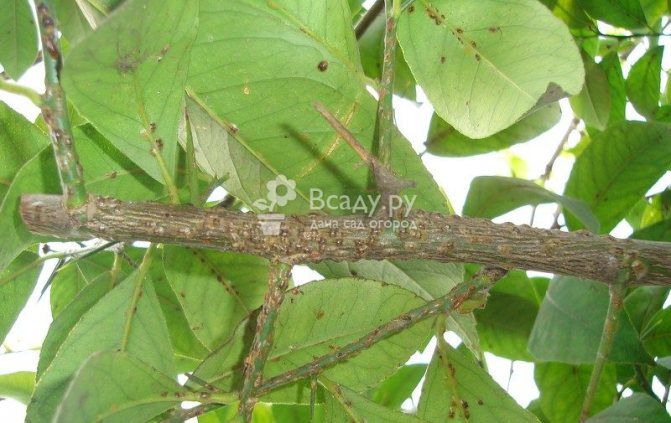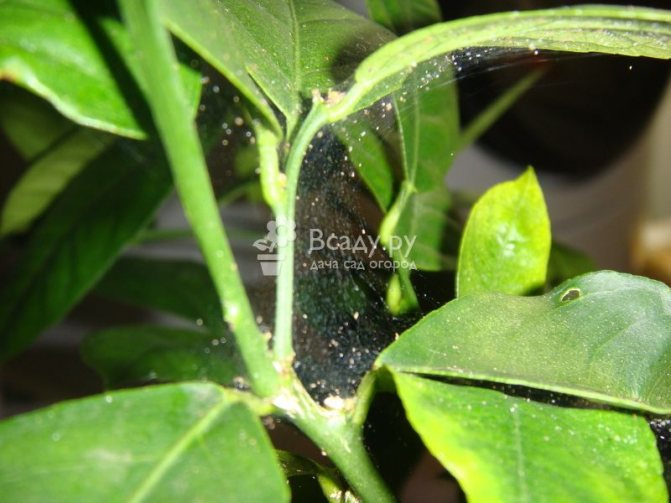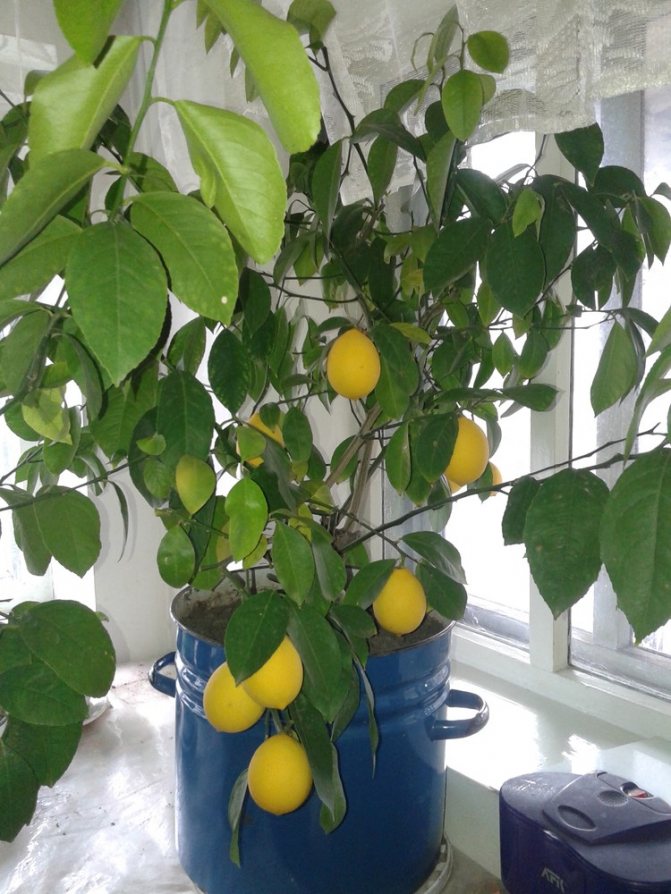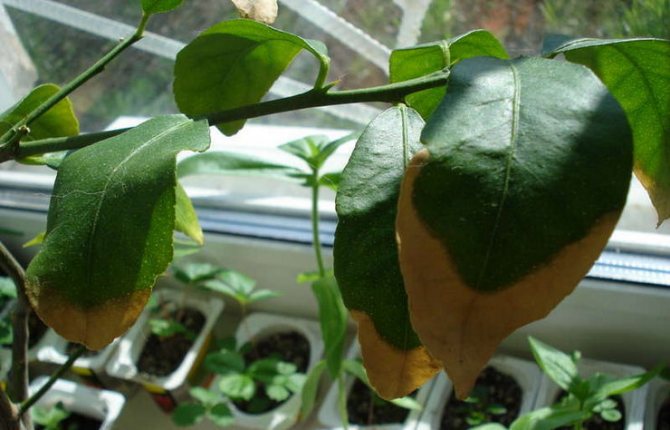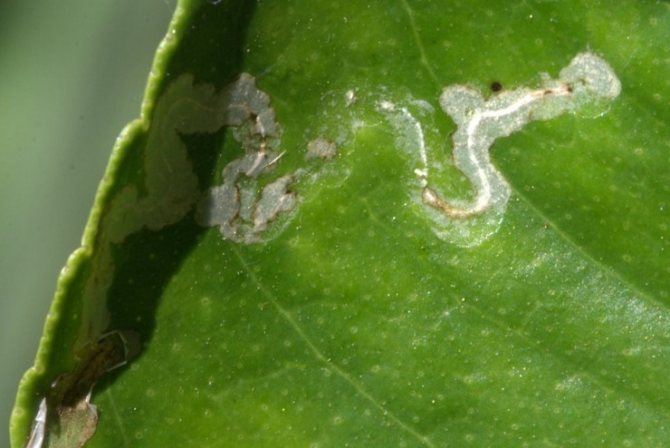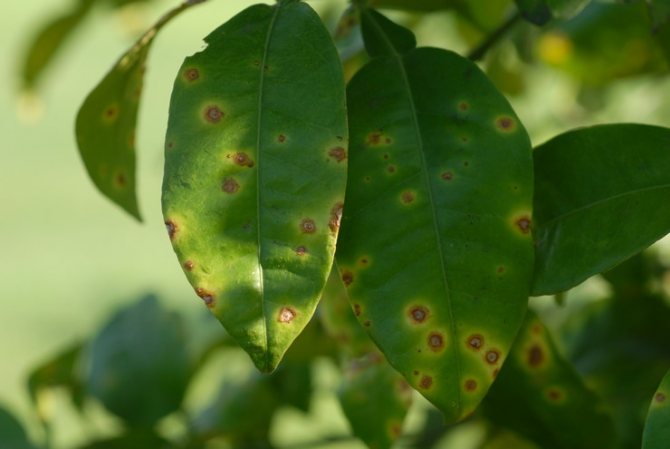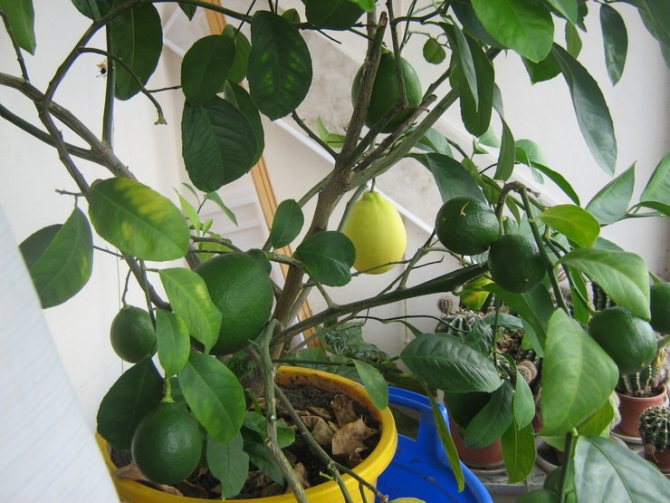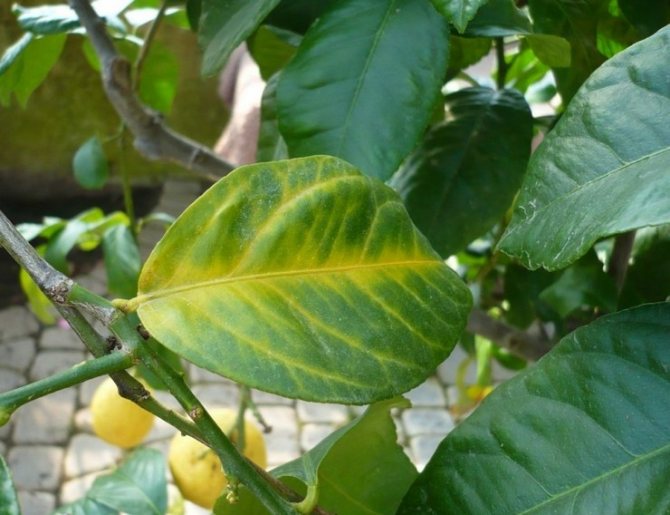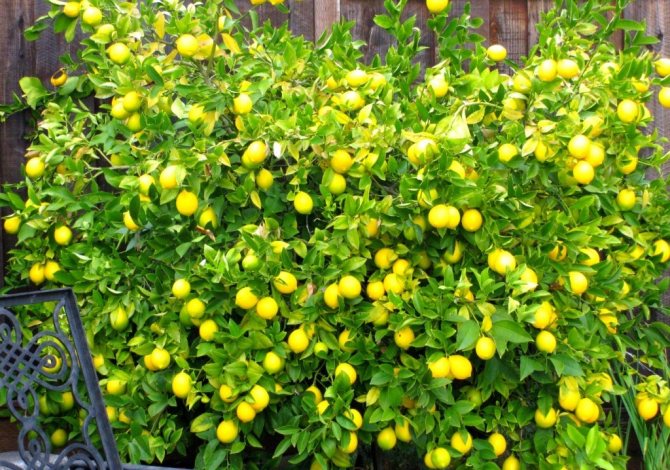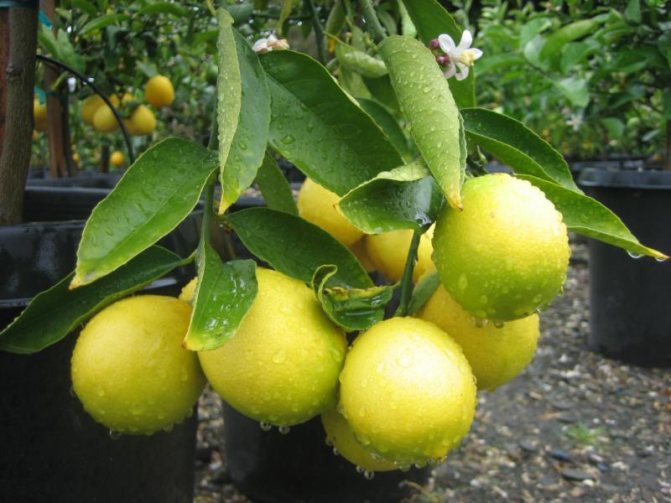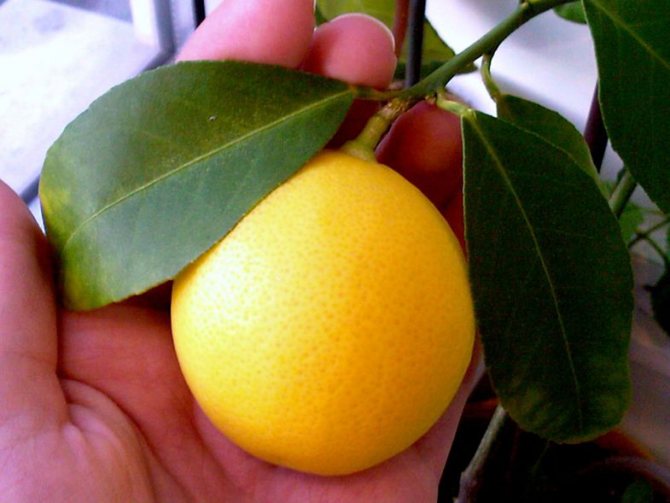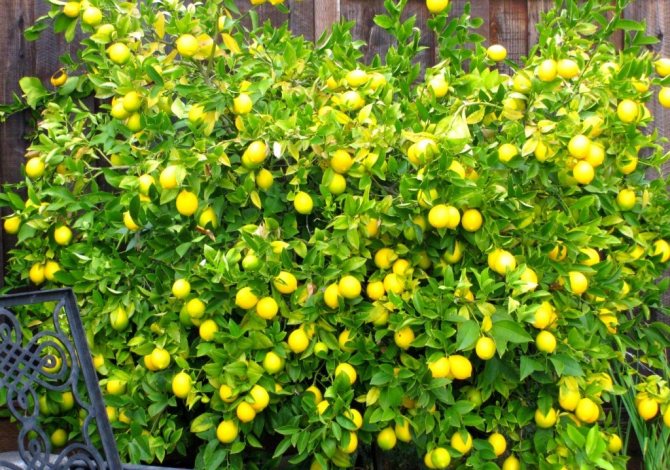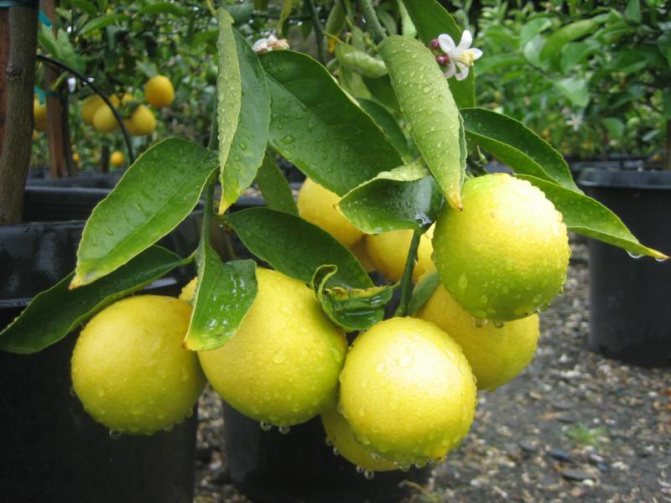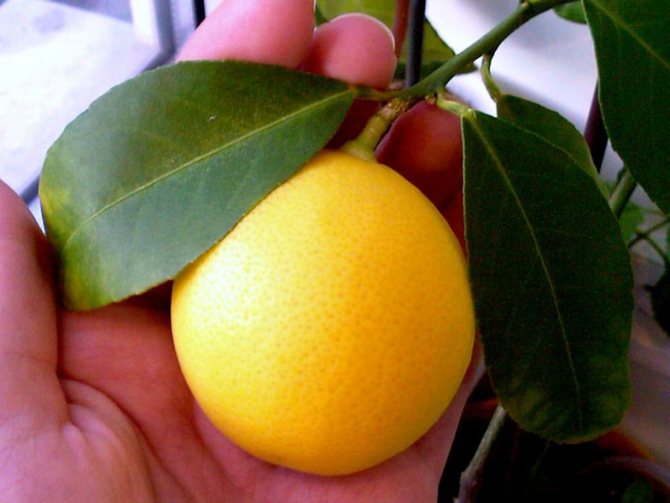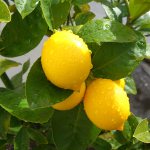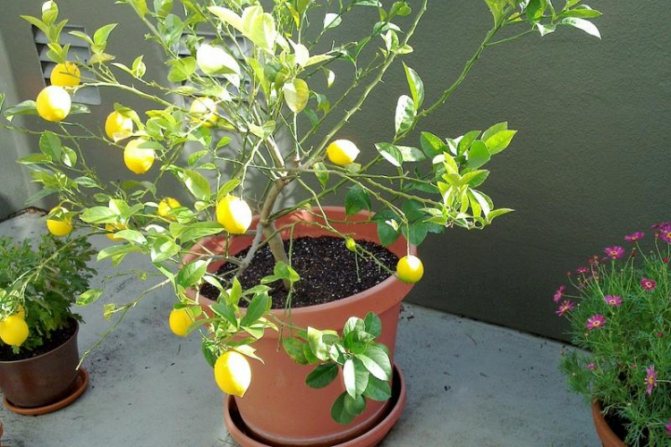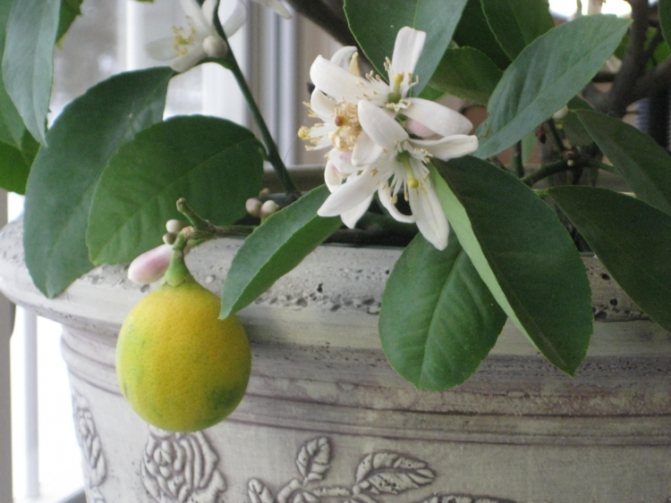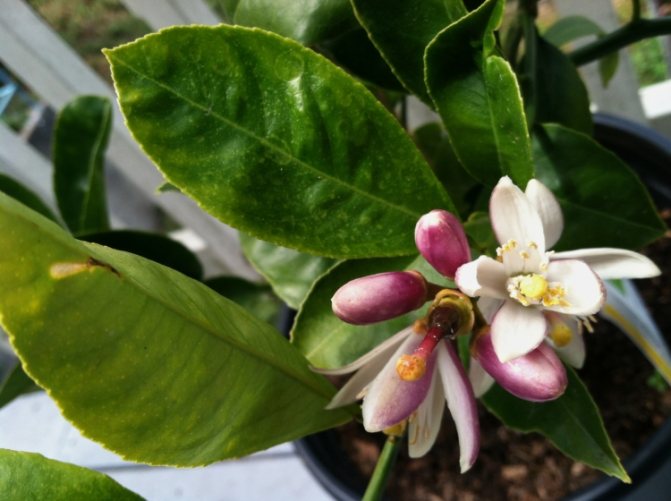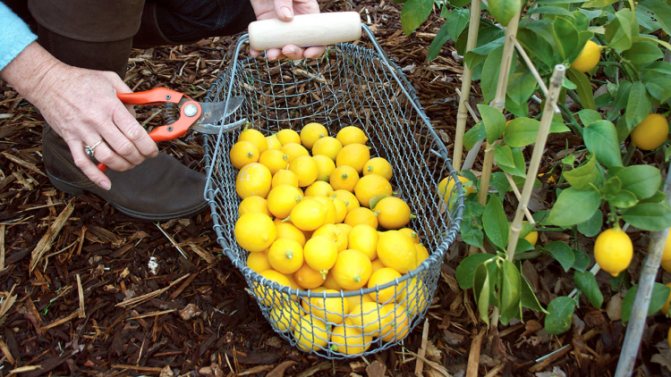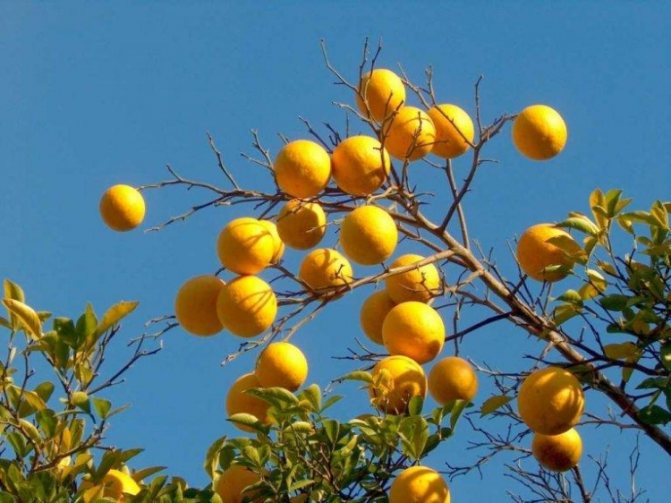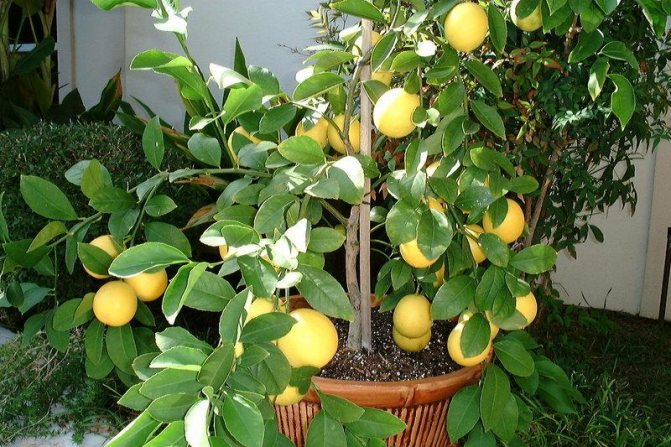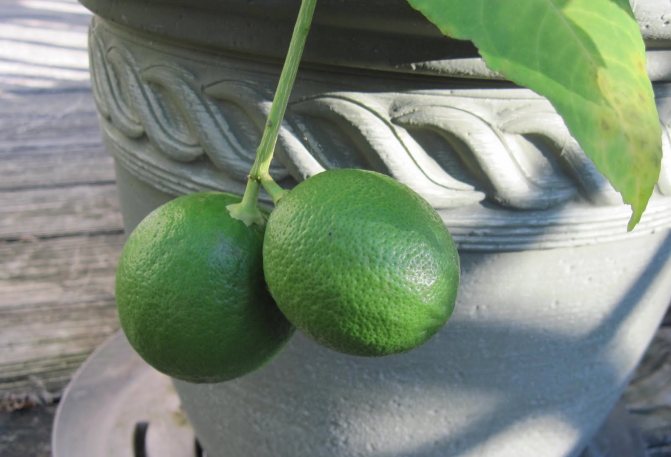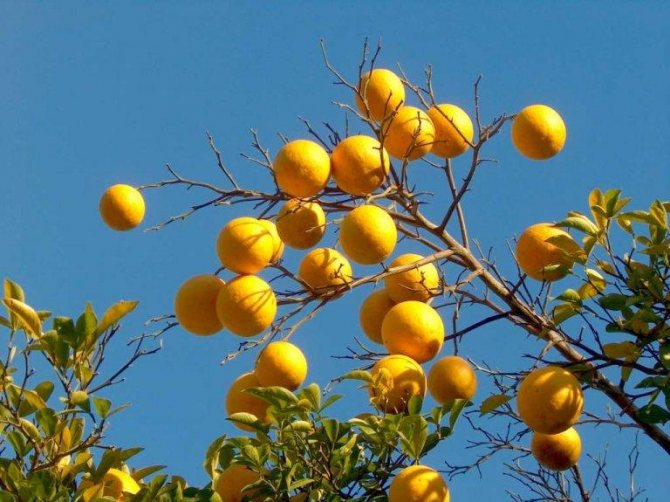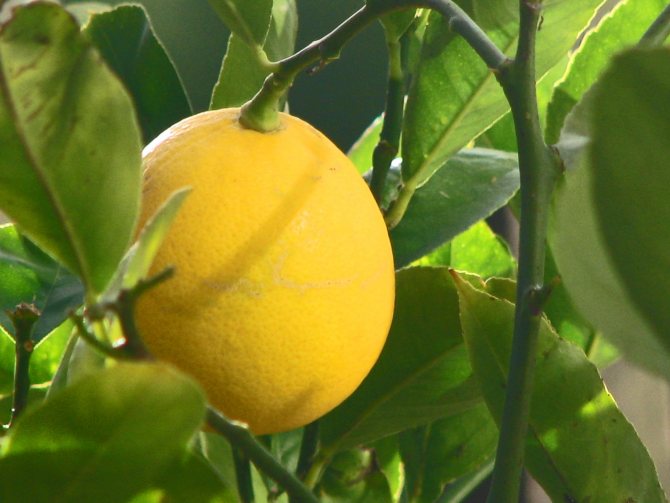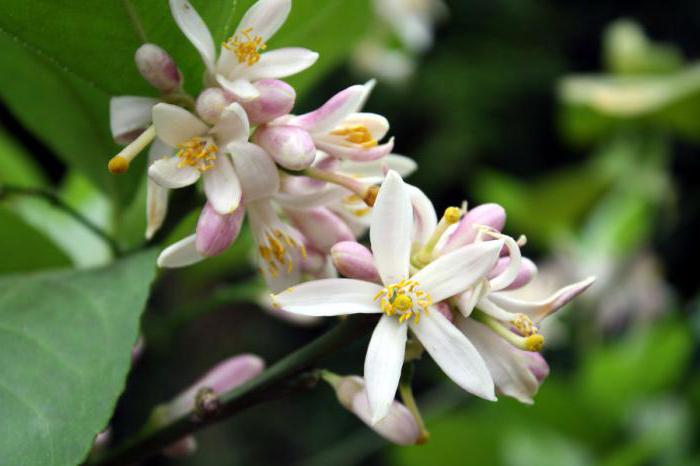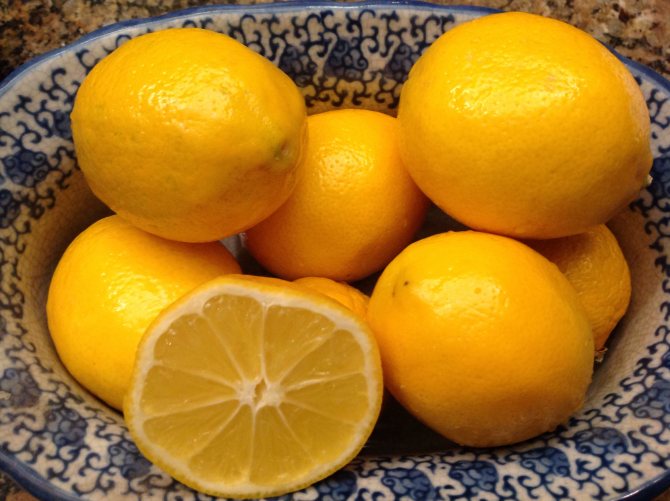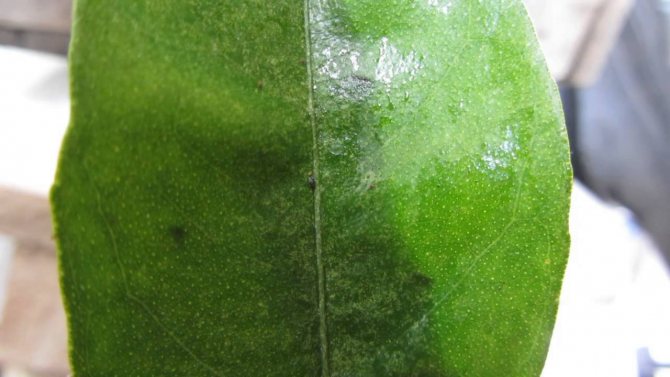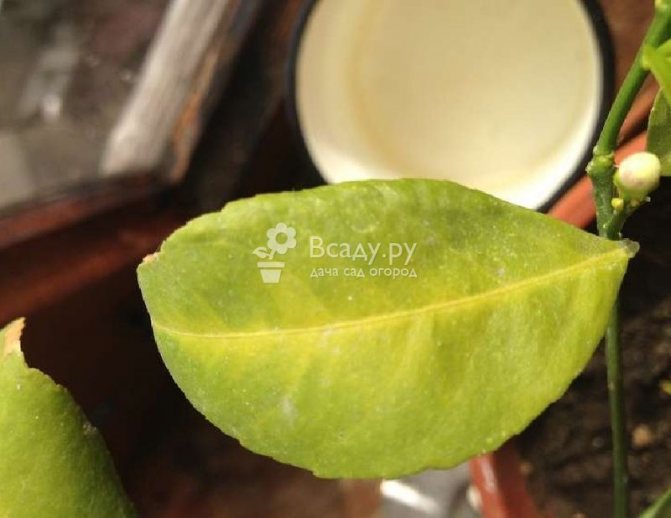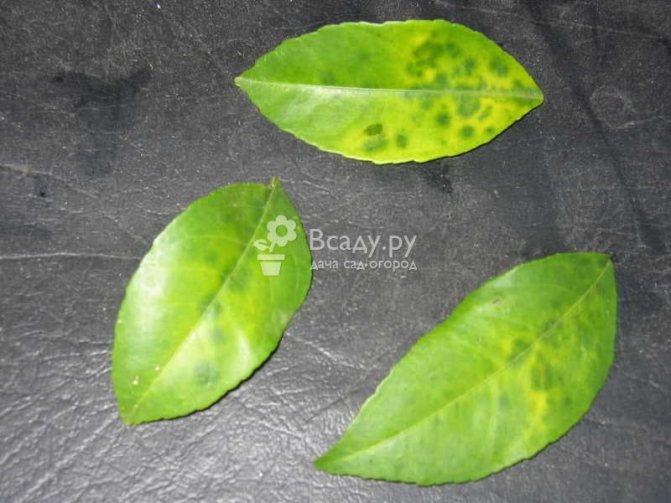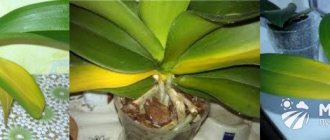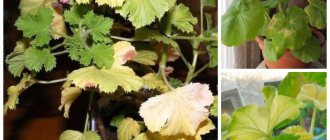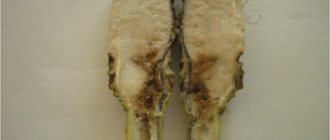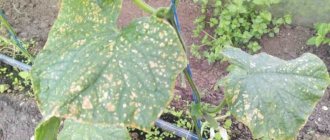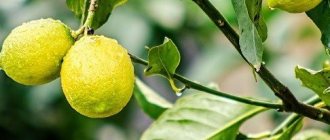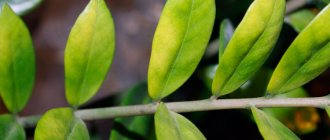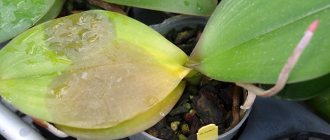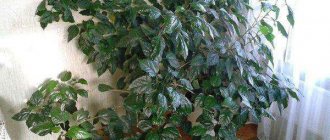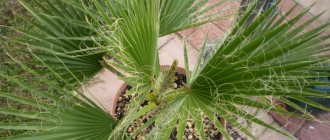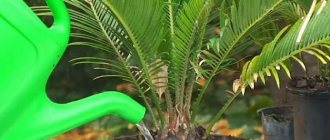Citrus meyeri is widely known among lovers of home citrus growing, it is distributed in many countries. In some of them it is also an industrial crop, occupying significant agricultural areas. Belongs to the classic hybrid varieties, significantly different from the representatives of the group of "real lemons". In the description of his appearance, as in the recommendations for care, there are many contradictions. Let's get to know him!
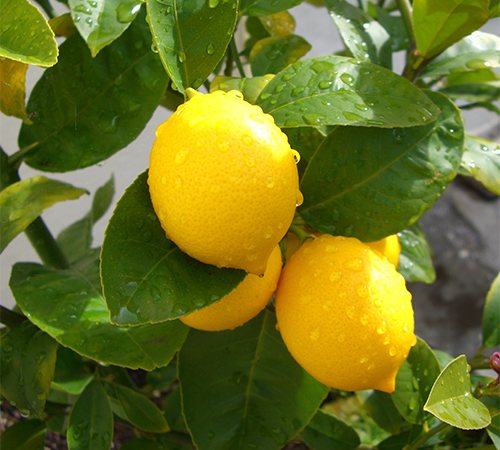
How to grow lemon at home and achieve fruiting
If you decide to create a citrus garden, then it is better to gain experience on indoor lemons. The most unpretentious of them is the Chinese lemon. But there are more and more clones, you need to choose the most successful bush for reproduction, or buy a ready-made grafted plant. If the right conditions are created, Meyer's lemon can bestow fruit the next year.
It is very important to comply with the conditions for keeping lemon. In case of deviations, he will begin to rebel, shedding foliage. The presence of 10 healthy, ripe leaves allows the indoor lemon to feed one fruit. And the more leaves on a tree, the more harvest it can give. But with negligence in care, the plant will shed flowers and ovaries, which will upset the household.
Lack and excess of fertilizers
Citrus fruits are quite demanding on the presence of nutrients and trace elements in the soil. If small yellow spots appear on the leaves between the veins, then it's time to feed the lemon, otherwise the plant will die. Specialized citrus fertilizers are ideal for feeding. Although you can balance your diet yourself.
But keep in mind that in addition to phosphorus and nitrogen, your pet will also need preparations with magnesium, iron, zinc, potassium, calcium, sulfur. So if you are not a fan of gardening, then it is better to buy a ready-made fertilizer. An overdose of fertilizers can provoke the simultaneous fall of all leaves at once. Do not forget, if you want to calmly feast on the fruits without risk to health, adhere to measures in the use of dressings.
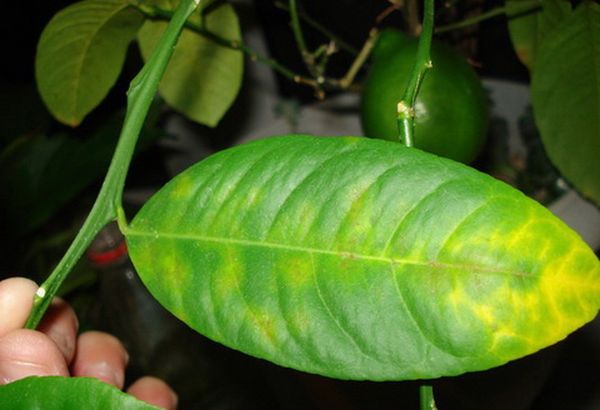

Agricultural technology of Chinese lemon at home
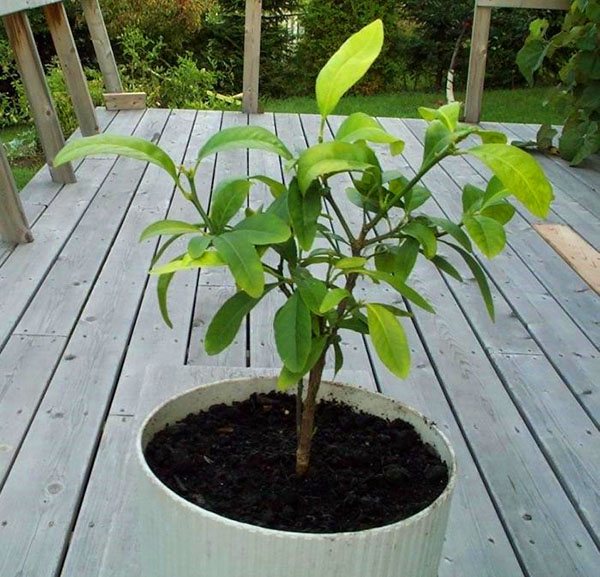

If the apartment has an insulated balcony, then the content of the Chinese lemon is simplified. It is this sort of lemons that are bred in the southern regions of the country in open ground with a little insulation. For vegetation in spring, the temperature should not be higher than 18 degrees. Otherwise, the ovaries will crumble, and the plant will slow down.
If you put a room lemon with pouring fruits outside in the summer or in the garden, the fruits will crumble. The tree is going through a sharp change in the situation painfully.
The best thing would be to provide the lemon with an even temperature of about 12-14 0 C in winter. As soon as the temperature is about the same on the balcony, move the lemon there until autumn. In autumn, it is impossible to bring a tree into a warm room right away - it will drop its leaves. It is necessary to change the temperature of the content gradually, allowing the earth to warm up. If the adaptation is successful, the leaves on the bush will remain.
The plant is demanding to create favorable conditions:
- lighting and proper placement;
- creation of temperature conditions;
- humidity regime and quality of irrigation water;
- regular top dressing and soil quality.


Indoor lemon care is more difficult.He needs to find a bright place, but at the same time prevent overheating. The higher the ambient temperature, the more the plant needs watering and spraying. In summer, it is normal to moisten the leaves in the morning and in the evening, but so that the sun's rays on the drops are not focused, and a burn does not turn out. You also need to water the pot twice. Soft warm water is poured over until a clod of earth gets wet and the water begins to filter through the drainage hole. In winter, when caring for lemon, watering is reduced, the leaves are not moistened.
It is necessary to strive to create light for indoor lemon about 12 hours all year round. With a long day, the leaf mass grows intensively. With a short one, the plant sheds its leaves and can get sick.
If watering is plentiful, there is a risk that the soil will be compacted and the water jet will flow out where there is less resistance. Lack of water will lead to yellowing and shedding of leaves. Therefore, up to five years, the plant is annually transferred into a large container. If the roots have not entangled a clod of earth, a transplant is not required. Later, the top layer of the soil is changed annually, if possible, the lemon is transplanted into a fresh substrate.
A rapidly developing plant needs to be fed with a complex composition of mineral fertilizers. The solution is introduced two hours after the morning watering of the soil.
The main rule is that Mayer's lemon does not like shocks. He needs even conditions of detention, a stable placement with a small rotation along the axis, for uniform illumination, and no drafts.
The twists and turns of lemon fate
One important event happened in the life of a Chinese tree on the new mainland. By the 40s of the XX century, being already a popular industrial variety, trouble overtook it. It turned out that almost all plants are carriers of the malicious tristeza virus, which killed millions of citrus fruits around the world. Those who did not die from the virus remained sterile. Themselves copies of Meyer almost did not suffer from the action of tristeza, but were asymptomatic carriers of the disease.
It was a verdict on the sort! The vast majority of his trees in the United States, and then in Europe, were destroyed.
But in 1950, the Californians managed to breed a species of Chinese dwarf, which practically did not become infected with the ill-fated virus. After numerous tests and checks, she was certified, and by 1975 she received permission for industrial breeding. The new clone began to be called the "improved Meyer".
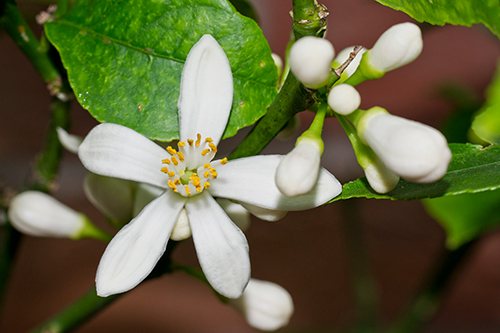

The problem is that in Europe and Asia there was no complete destruction of the "old clones", as happened on the American continent. Now they are mixed with the "improved version", so much so that sometimes without laboratory studies you will not understand who is in front of you. Tristeza continues to wreak havoc on citrus plantations.
There is also a distinct "Soviet trace" in the fate of our hero. Back in the 30s, he was introduced from America to the Soviet Union. Scientists from the Soviet Union, having studied the guest, came to the conclusion that it will grow well on the Black Sea coast of the Caucasus due to its increased winter hardiness. In addition, here they began to graft him on a tripolyate, and kept him in the open field. To the surprise of breeders, the "American" grafted on the tripoliate was significantly less infected with tristeza. Since then, it has remained one of the most popular in the Union, and many people still call it "Abkhazian".
Why does a lemon need pruning?
In order to create a tree, it is required to form a plant from an early age. If growth is not regulated, the plant tends upward. By means of multilevel crown formation, conditions are created for obtaining a leafy, compact, dwarf plant.
Annual spring pruning, summer pinching, and light branch removal during harvest are essential to harvest indoor lemon in your home.Flower buds are formed on new shoots, the laying of a future harvest takes place. On young plants, the number of buds is manually adjusted. An adult tree sheds excess color by itself, determining the load.
Even before the first flowering, the bush is formed in several stages:
- A young plant of the first year of life with a height of more than 20 cm is pruned, leaving 6 lower leaves. After a while, several new branches will grow on the sides, one of them will be the central one.
- After waiting for several upper branches to grow up to 20-25 cm, they are cut again, like the first central one. Later, after regrowth, branches of the second order are formed.
- The branches of the third order are formed in the same way. As a rule, flower buds begin to form after the third pruning.
Common problems with growing lemons
The natural habitat of citrus fruits is the tropics; it is rather difficult to achieve such a climate in an ordinary city apartment. Therefore, many flower lovers find their cultivation somewhat troublesome. At the same time, several of the most common problems are noted. In particular, the tree can shed its leaves, stop growing.
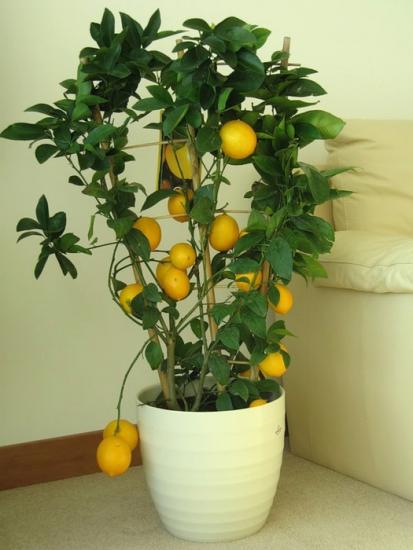

The reasons for such phenomena can be a wide variety of factors: from insufficient volume of soil to the container to excessive dryness of the same soil or even air in the room. In addition, plants are sensitive to mineral and nutrient deficiencies, as well as to the quality of lighting.
But even more often you can find on the forums complaints from amateur flower growers that yellow leaves are observed on lemon. We will try to deal with this issue.
How Chinese lemon is propagated


There are several tricks on how to plant a lemon and speed up your first harvest. The most common breeding method is cuttings. Branches cut in spring are full-fledged cuttings for rooting. The lower cut must be necessarily oblique, under the lower kidney. The leaves are pruned so that evaporation is less and the stalk will receive nutrition and will not dry out.
You can root the stalk in water, or in a greenhouse with damp sand, but the stalk should not touch the film or the walls of the vessel. In the lower part, a collus is formed, roots grow from it. If rooting is under the jar, the cutting is sprayed.
You can grow a seedling from a drupe, but if you need to get a fruit tree, you will need a graft from a varietal lemon. It is done on a two or three year old seedling by means of splitting, by cutting by the bark or by simple copulation.
A sand-peat mixture is used for rooting cuttings. Young seedlings need fertile soil. Its composition:
- sand - 1 part;
- humus - 1 part;
- turf - 2 parts;
- sheet land - 1 part.
Read also: What can be used to make a doghouse
For an adult plant, more sod land and a little clay are added to the substrate. When creating a mixture, ash is added to the ground. The drainage layer consists of expanded clay and charcoal.
Having fulfilled all the conditions for keeping Meyer's lemon in the room, you can expect the return from the citrus tree in the form of delicious fragrant fruits.
Meyer's indoor lemon video
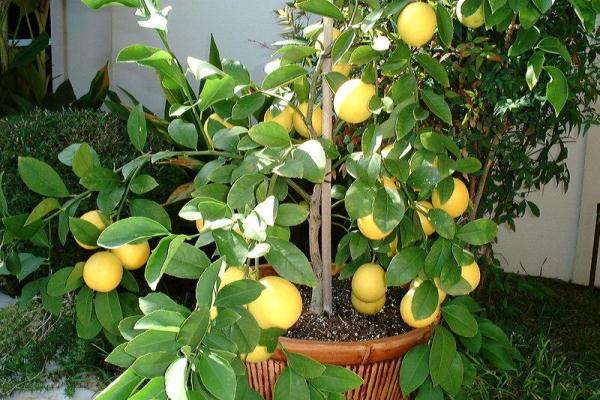

Lemons in apartments on windowsills are no longer considered a rarity, but in order to grow this exotic fruit, you need to know all the features of care. Also it is very important to choose the right variety, which will delight not only in appearance, but also with tasty and juicy fruits. In this article, let's take a look at the Meyer lemon.
Diseases and pests in which leaves turn yellow and fall
If your lemon was green, received timely feeding and watering, enough light, but still began to turn yellow, then look for the cause in the disease or pest attack.
Methods of infection and methods of struggle
The plant itself cannot get sick, so you need to establish the source of infection.
Recent Entries
Rose Petal Jam and Its 7 Health Benefits You Likely Didn't Know About What Fruit Are You According to the Zodiac Sign 11 Best Grape Varieties That Will Help You Create Unique Homemade Wine
Infection from new "neighbors"
If the lemon is infected from other plants, proceed as follows:
- Examine all nearby plants and find the source of infection.
- Process it first, and then your lemon. Look carefully to see if parasites or diseases have spread to other plants.
- Since the lemon does not like it when its geography is changed, rearrange other plantings further away to avoid a repeated wave of infection.
- Wait 2-3 weeks. Then you can return neighbors if your design requires it.
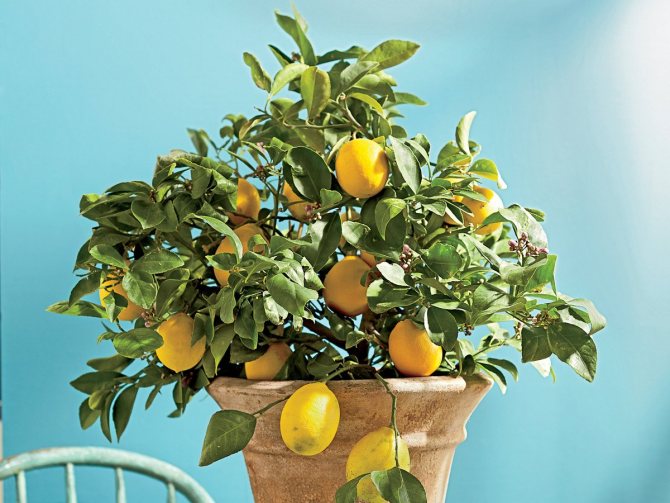

Remove other plants for the duration of the treatment, and leave the lemon in the same place.
Infection through the window
In rare cases, infection can occur through an open window. The actions in this case are the same: we send the lemon "to quarantine", we spray the plants and the earth with preparations.
Infection through soil
Changing or adding soil containing viruses, harmful bacteria or insect pests is also a source of infection. In this case, you can either change the soil again and treat the plant, or use fungicides and insecticides for both the earth and the lemon. During budding and fruiting, drugs that have the "BIO" sign, that is, harmless to humans, should be used.
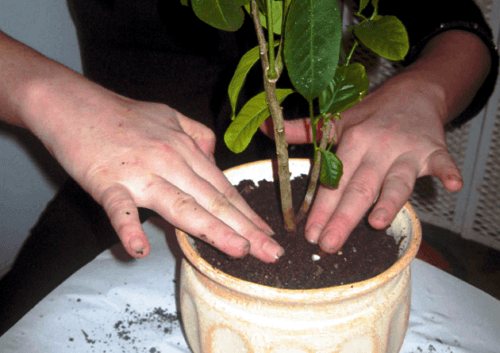

If the lemon gets infected when changing soil, you can change the soil again.
Definition and treatment of diseases
The correct diagnosis is the correct treatment. To determine the disease, carefully examine the tree or bush.
Anthracnose
This is a fungal disease in which the foliage turns yellow and falls off. Typical signs:
- dying off of branches;
- falling buds;
- the appearance of reddish spots on the fruit.
For recovery, cut off dead branches, remove spoiled fruits, spray the plant 2-3 times with an interval of 4 days with Fitosporin or 1% Bordeaux mixture.
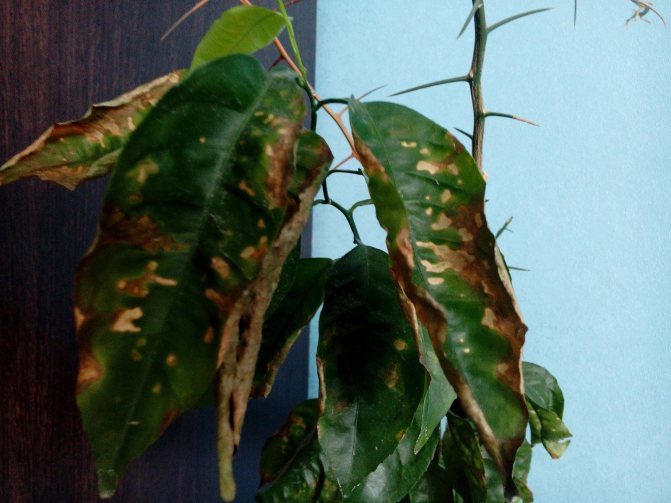

With anthracnose, leaf segments turn yellow and dry
Chlorosis
Violation of the formation of chlorophyll in the leaves can lead to the death of the plant. Typical signs:
- yellowing begins from the edge of the leaf, while the veins remain green;
- the shapes of the bud and flowers change;
- the size of new leaves decreases.
For healing, the plant is watered, and the leaves are sprayed according to the instructions:
- Ferovit;
- Antichlorosis;
- iron chelate.
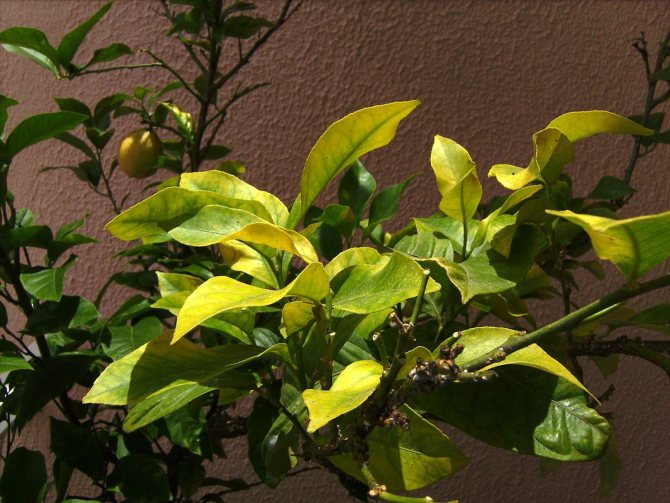

With lemon chlorosis, it is difficult to wait for the harvest
If the dosage for spraying the foliage is not indicated on the labels, then the dosage for irrigation is taken and diluted with water (2 parts of water to 1 part of the solution).
Characteristics of Meyer's homemade lemon
It's believed that Mayer's lemon or Chinese lemon is a hybrid of orange and lemon, created not in scientific laboratories, but by nature itself. This variety was discovered by the American Frank Mayer, who brought it from China to America in 1908.
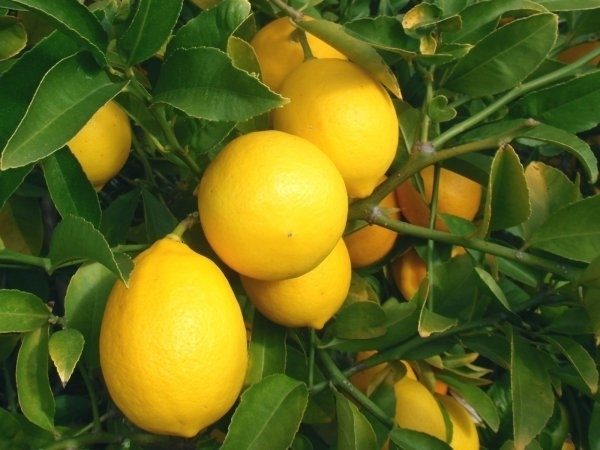

Meyer's indoor lemon
Chinese lemon is the smallest among the representatives of this culture and that is why it is often grown at home. The variety has good frost resistance and yield., tolerates not the most favorable climatic conditions.
The maximum tree height reaches 1.5 meters , leaves are oval, saturated green color with a characteristic shine. The variety is remontant, that is, it blooms and bears fruit all year round and in one season you can take several crops with a total weight of 2-3 kilograms. The first fruits can be removed only for 2-3 years of the tree's life.... The highest peak of flowering is observed in the spring, with the formation of white flowers, collected in bunches of 6-8 pieces.
From the moment the ovary is formed until the fruit is fully ripe, it takes 8-9 months. Lemons of the correct rounded shape can weigh from 70 to 150 grams, the skin is thin, bright yellow. The pulp is orange, sour with a slight bitterness; many tasters evaluate this taste as noble.
Why home lemon does not bloom
Sometimes it happens that citrus does not bloom for a very long time. In this case, the tree can be pushed to bloom by grafting with a cultivated cuttings. After that, flowers will appear in 2-3 years. The reason why home lemon does not bloom may be the lack of a cool wintering (at a temperature of 12-15 ° C), when the plant has flower buds. In a warm room, without a dormant period, citrus may not bloom. In addition, the tree may lack micronutrients.
Lemons grown from seed very rarely bloom and bear fruit. To achieve flowering, it is necessary to graft a branch of a fruiting plant. Flowering will come in 3-4 years.
When planting a lemon, you should be aware that some varieties bloom annually, while others once every 4-5 years.
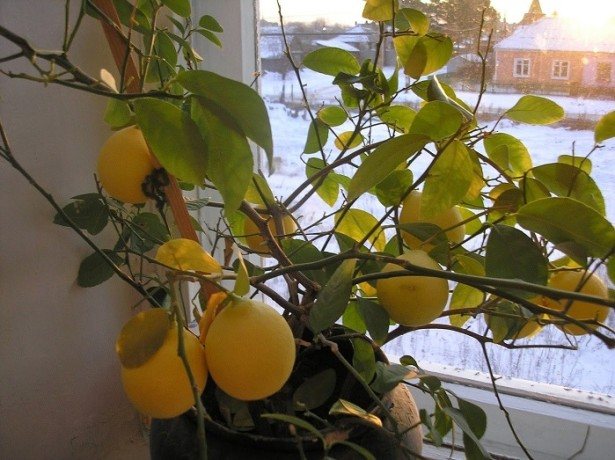

Advantages and disadvantages
- Mayer's lemon not afraid of cold temperatures and can grow in almost any climatic conditions;
- The tree itself has an excellent decorative appearance and can become a decoration in any room;
- The fruits are very beautiful and at the same time deliciousthat can not but rejoice florists;
- Flowering and fruiting lasts constantlytherefore, with proper care, several crops can be harvested per season.
- Besides all the pluses, Chinese lemon has minuses such as the need for constant and high-quality care, in the absence of which the tree can quickly get sick and die;
- There is also a high risk the appearance of various pests;
- Fruit not suitable for long-term storage and long distance transportation.
Why lemon does not bear fruit
It so happens that a tree blooms, but does not bear fruit. Why doesn't the lemon bear fruit? There may be several reasons for this. The most common of these are lack of nutrients, low air humidity, and lack of light.
With insufficient feeding, the ovary, which has developed to the size of a walnut, crumbles. Sometimes, with scant feeding, the ovary ripens, but the fruits remain small.
The lack of fruiting can be attributed to poor pollination. In this case, you need to dust the flowers with a cotton swab, transferring pollen from one flower to another.
To get a rich harvest of lemons, you need to create all the necessary conditions for the tree and ensure proper care. So, for example, in the absence of a state of dormancy, the development of a plant is disrupted, which directly affects its fruiting.
Landing rules
Usually, ornamental plants are already sold in pots, but in order to create more comfortable conditions for him, it is necessary to transplant a lemon, while adhering to some rules.
The following potting soil works well for young plants:
- one piece of leafy land;
- one piece of sand;
- one part of humus;
- two parts of turf land.
For older lemons, the composition of the soil changes slightly:
- one piece of leafy land;
- one piece of sand;
- one part of humus;
- one piece of clay;
- three parts of turf land.
A neutral acidity level is preferable. When planting, you need to monitor the position of the root collar, it should be flush with the ground.
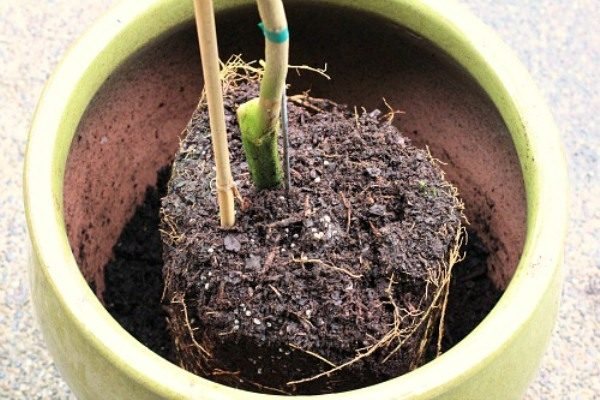

The root collar of Meyer's lemon should be flush with the ground
Until the lemon tree has grown to 5 years of age, it must be replanted annually., while renewing the soil and increasing the size of the previous pot by 4-5 centimeters. As soon as the plant becomes more mature, transplants are carried out once every three years, completely changing the soil mixture and replacing the pot if necessary.
Testimonials
This is chlorosis, possibly due to the fact that the soil is not pleasant, or due to excessive moisture, the soil has soured and the lemon cannot fully absorb the necessary nutrients from the acidified soil.
Tatnka
Is chlorosis caused by flooding and soil acidification? I hope that the plant will get out, I will now water much more moderately, especially since the dormant period begins.
sasha2450
I regularly use Ferovit. When growing citrus fruits, mistakes and errors in care are inevitable (for example, my plants are often under extreme watering conditions - they are not watered for a long time, and then a lot at once), in addition, being in a limited volume of soil, fruiting plants are depleted, a universal preparation is needed, stimulating tissue respiration.
vivas
I had the same situation: I passed into a too large pot, the earth did not have time to dry out and was still heavy. The roots began to rot, I saw, taking out a lump from a large pot. Took another land, reduced the pot. The leaves, which began to turn yellow a little, eventually all fell away.
Konstantin
Yellowing of the leaves most often indicates the transition of the tree to internal nutrition (with the exception of viral diseases and pests). Find out the reason for such a reaction and only then proceed to the "liquidation of the consequences."
Lemon tree care
So that the tree grows strong and healthy you need to take care of him properly, while creating as comfortable living conditions as possible, close to the region of natural growth of such a plant. There are several aspects to quality care.
Lighting
In order for the plant to be able to fully bear fruit, it must be provided with intense sunlight throughout the year. The best option would be to create a 12 hour day, in such conditions, the tree actively grows foliage, but if the number of light hours decreases, then there is a risk that the lemon will lose all the green mass and simply die.
Florists recommend placing a pot with a plant on a western or eastern window sill, while artificial lighting is required in winter.
Temperature regime
Mayer's lemon does not tolerate drafts and sudden changes in temperature very well, therefore it is not recommended to take the plant out to an unglazed and unheated balcony or on the street.
In the summer, it is important to avoid overheating, so in intense sunlight and a lot of heat, it is best to slightly shade the tree so that it receives the right amount of light, but does not burn from high temperatures. The ideal indicator is considered to be 20 degrees Celsius..
In winter, it is necessary to maintain the state of rest of the lemon tree; for this, the pot is transferred as far as possible from the batteries, trying to provide the plant with a comfortable temperature of no higher than 12 degrees.
Watering
For a comfortable existence plants are recommended to maintain indoor humidity at 70 percent.
Water the lemon tree with both root and foliar method. Simultaneously moisturizing the soil and spraying the foliage from a spray bottle. In the spring and summer, the procedure is repeated in the morning and in the evening every day, in the autumn and winter, the frequency of watering is reduced to 2 times a week.
Pruning
To form a beautiful crown of a tree, you need to take care of its pruning in advance, for this you need:
- Grown up the stem of the seedling is shortened to a length of 20 centimeters , while leaving several developed buds in the upper part;
- Grown from the remaining kidneys shoots will become skeletal branches, of which 3-4 are the healthiest, and the rest are cut off;
- Skeletal branches trimmed to a length of 25 centimeters ;
- Shoots of the second order should be no more than 10 centimeters;
- Third order - more than 5 centimeters.
Read also: Do-it-yourself patchwork panel on the wall


Meyer's lemon pruning scheme
As soon as the shoots of the 4th order appear, the formation of the crown of the tree is considered complete... Now, every year in the spring, they carry out sanitary pruning, removing all diseased, yellowed, dried or damaged leaves.
Lemon turns yellow: causes, treatment
Breeding citrus fruits at home is not only interesting, but redder and more useful. We all know about the benefits of vitamin C for the body, and citrus plants are rich in this vitamin. Also, leaves of oranges, lemons, tangerines and grapefruits contain special volatile phytoncides that kill harmful microorganisms that live in large numbers in any living space and are brought from the street. Therefore, many flower growers believe that a lemon or a tangerine on a window is not only a beautiful exotic, but also a huge benefit for the body.
But in the cultivation of citrus plants, there are many subtleties and nuances, not observing which many breeders of these plants simply lose their green pets. In this article, we will talk about why citrus fruits (lemons, oranges, tangerines, kumquats, limonella, etc.) turn yellow, curl and fall off the leaves. Namely, using the example of indoor Pavlovsky lemon, we will analyze all the reasons for yellowing and falling leaves, as well as talk about methods of treatment.
Leaves turn yellow
Possible reasons:
Citrus leaves turn yellow mainly due to lack of nutrition, lack of light.
Treatment:
Nutrition is very important for almost all plants and citrus fruits are no exception. Lemon needs basic elements for productive growth, flowering and fruit setting: nitrogen, calcium, phosphorus, iron, potassium, sulfur, magnesium. Nitrogen is required for all vital processes, especially at the beginning of growth and during flowering. Nitrogen also contributes to healthy leaf color.
Calcium contributes to the full development of the root system and green mass of the plant.
Phosphorus is a part of complex proteins and participates in the construction of plant cells, brings fruiting closer, improves the quality of fruits, increasing the content of sugar and vitamins in them. Normal phosphorus nutrition contributes to the respiration of citrus fruits, good development of their root system, the formation of ovaries and, therefore, productivity. Therefore, the highest efficiency of phosphorus is manifested at the beginning of the growing season, but with the simultaneous introduction of other elements into the soil, primarily nitrogen and potassium.
Iron plays a significant role in the respiration process and in the formation of chlorophyll in plant cells. In microdoses, plants also need other elements, as well as vitamins (for example, C, B, B12, E, K, provitamin A, or carotene), which accelerate the accumulation and expenditure of energy, the conversion of some substances into others, and contribute to the growth and reproduction of plants ...
In turn, potassium promotes nitrogen absorption. In addition, it increases the intensity of leaf photosynthesis, improves the metabolism of citrus fruits, and promotes the accumulation of sugar in fruits.
Potassium accelerates the ripening and lignification of shoots, the ripening of fruits, increases productivity, as well as the resistance of trees to diseases.
Magnesium is involved in the construction of tissues, and together with phosphorus, in all metabolic processes occurring in citrus fruits.
Lemon needs 12 hours of daylight, especially in winter. The location of the plant should be oriented towards the southwest or southeast windows. For additional illumination, it is advisable to place special lamps above the plant.
Lemon leaves turn yellow from the veins
Possible reasons:
The most common cause is a lack of nutrition in the soil, as well as a lack of iron in the soil. In second place, homemade lemon leaves turn yellow due to pests.
Treatment:
If the lemon is planted in a small container, then we recommend transplanting it into a more spacious pot and a week later start feeding it with fertilizers, as well as iron-containing preparations. If pests are found (spider mites, scale insects, mealybugs, etc.), then it is necessary to take measures to combat them by treating the plant with special insectoacaricides.
Lemon leaves dry and fall off
Possible reasons:
The most important reason in this case is dry air. Most often, lemon leaves turn yellow and fall off in winter when the heating is turned on. But citrus fruits are subtropical plants and constant air humidity and long daylight hours are very important for them.
Treatment:
To recreate conditions similar to native ones, the lemon should be placed away from batteries, closer to a container with water or a water spray. You can spray the lemon by hand with soft warm water as often as possible. In a warm, dry room, moisture evaporates quickly, and the humidity drops quickly, causing the leaves to dry and fall off.
Lemon leaves dry at the ends
Possible reasons:
Again, dry air is the culprit for this problem, which leads to yellowing of the tips in citrus fruits. And only in a small percentage of cases the presence of pests can be a problem.
Treatment:
Increase air humidity, normalize watering and / or get rid of pests
Lemon leaves curl at the ends
Possible reasons:
If the leaves on a lemon curl and then turn yellow, the main reason is dry air, insufficient watering and pests.
Treatment:
Provide sufficient air humidity, normalize watering and get rid of pests.
Leaves of lemon are falling sharply
Possible reasons:
Most often, a sharp fall of leaves of green lemon leaves is associated with stress, namely: a draft (open windows and vents in cool weather), overflowing or underfilling the soil, rearranging the pot to a new place.
Treatment:
Carry out all measures to ensure optimal conditions for the full growth and development of the lemon: remove the plant from a draft, stop watering for several days when flooding, or transplant the lemon into new soil.
Reproduction methods
Meyer's lemon can be propagated by seed or cuttings... It is worth noting that with the help of cuttings, you can get a good, varietal tree, and when growing a tree from a seed, there is a high risk of wild life.
Using seeds
- seeds are extracted from the fruit, thoroughly washed and dried on the windowsill;
- then need moisten gauze in water, put seeds on it and remove such a structure in a box, while constantly maintaining the moisture of the fabric;
- as soon as the first shoots appear, seeds are transplanted into the ground, adapted for young plants, while the seeds are deepened by 3-4 centimeters;
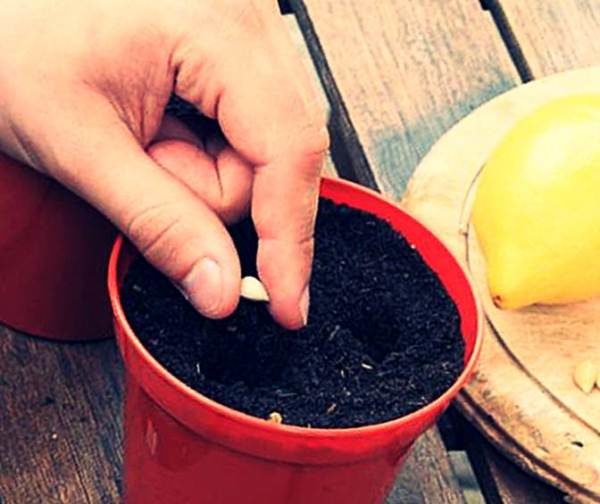

Growing Meyer's lemon from seed
- seedlings are watered once every two days;
- as soon as the height of the tree reaches 15 centimeters, it transplanted into a large container.
By cuttings
- stalk with 4-5 leaves placed in a weak solution of manganese for 20 hours;
- then an oblique cut is processed with a crushed corner, remove all castingsleaving only the top 3;
- to the bottom of the pot lay out drainage, then the soil mixture, on top of the sand, into which the plant is deepened by 2-3 centimeters;
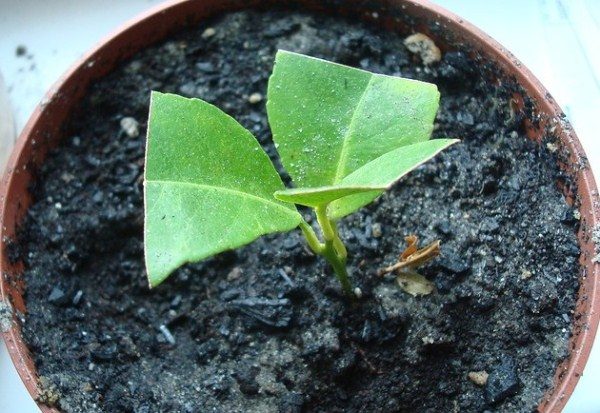

Propagation of Meyer's lemon by cuttings
- at the next stage cover the pot with a glass jar or a plastic bag;
- for the best rooting, the structure is placed in a place with diffused light and regularly moisten the soil;
- after 2-3 weeks, the shelter is slowly removed, first for 2 hours, then this time is increased. Carrying out such a manipulation is necessary so that the lemon can adapt to environmental conditions.
Why does lemon shed its leaves
At different times of the year, citrus sheds its leaves, but more often this can be observed in the autumn-winter period. The reasons why the leaves of a lemon fall off are usually related to the unfavorable conditions of the tree.
With a lack of light, the plant is depleted and begins to lose foliage. This happens quite often in winter. In this case, additional illumination with special lamps is required.
Other reasons why lemon sheds its leaves are dry indoor air, lack of nutrition, insufficient watering, a cramped pot, hypothermia of the roots, soil acidification, a sudden change of place, premature flowering. To eliminate this problem, you need to provide the plant with regular watering and timely fertilization. If the pot has become cramped, the tree is transplanted into a larger container. To prevent hypothermia of the root system, citrus should be watered with water at room temperature or slightly warmer. Don't keep it on a cold windowsill. It is important to regularly monitor the condition of the soil and its moisture content. With an excess of moisture, the roots begin to rot, which leads to the shedding of leaves.
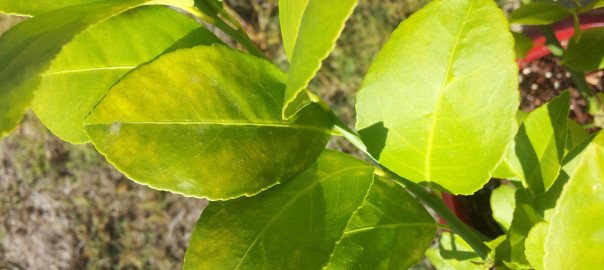

When transplanting a tree into a larger pot, soil acidification may occur. To avoid this, the new pot should be 2-4 cm larger in diameter than the previous one. Leaves often fall off immediately after transplanting, so lemons are initially planted in spacious containers.
Since the lemon quickly gets used to its permanent place, it reacts negatively to rearrangement and hardly gets used to new conditions, as a result of which it can shed its foliage.
Citrus leaves can fall off under the influence of pathogens and various pests, such as scale insects or spider mites. In order to timely identify and eliminate pests, it is recommended to periodically inspect the tree.
What if the lemon has dropped its leaves? In some cases, the plant recovers on its own. However, it is necessary to exclude all possible reasons: to prevent drafts, ensure timely watering, optimal air humidity. Fertilizer is applied only if the plant is healthy. If the tree has been rearranged to a different location, you need to return it to its original location.
Diseases and pests
Improper care can cause some diseases that can be identified by the following signs:
- If the leaves brighten, then this means that the tree lacks nutrients or light;
- If leaves begin to wither and fall off, then there is a lack of moisture and you need to immediately start watering and spraying the plant.
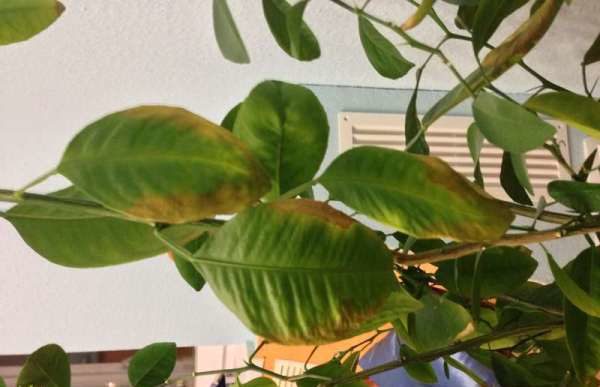

If the lemon leaves begin to turn yellow, this indicates a lack of nutrients.
Also, lemon is often attacked by various pests..
- When a spider mite settles on a plant, he begins to build cobwebs and at the first detection of such a sign, the tree is washed under running water from the shower;
- If black dots appear on the leaves-turtles are scale insects, which will help get rid of a mixture of 50 milliliters of kerosene and 100 milliliters of liquid soap.
Mayer's lemon is great for growing in an apartment as an ornamental variety, which also produce excellent-tasting fruits. Initially, it may seem that caring for such a plant is very difficult, but if you follow all the instructions correctly, you can get a good harvest and no diseases and pests will be scary.
Meyer's lemon belongs to the Rutaceae family of the Citrus genus. It is a hybrid obtained in vivo from pomelo, citron and mandarin. It occurs naturally in China, from there it is introduced to the United States and other countries. In the homeland, the tree is classified as decorative, and in America and Russia, the fruits are used in various recipes.
Why do ovaries and lemons fall
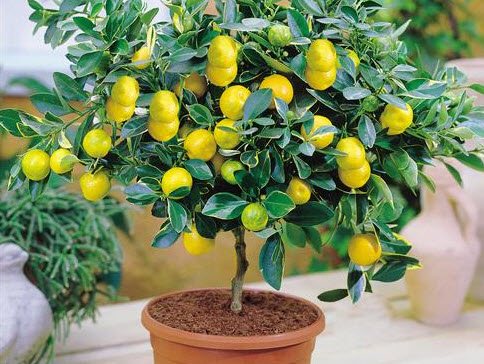

It so happens that the citrus has bloomed, but the ovaries have crumbled.Why do lemon ovaries fall off? Most often this happens due to dry air, in the presence of drafts, excess moisture, as well as a lack of nutrients. The fall of the ovary can be caused by the scale insect and spider mite.
Why do lemon fruits fall? During fruiting, citrus reacts painfully to even a slight lack of nutrients, as a result of which its yield decreases.
To get a good harvest, potash fertilizers are applied to the soil in the autumn. You can prepare a solution from water (1 liter) and wood ash (2-3 tablespoons).
It should also be borne in mind that the tree sheds the ovary when it feels that it is not ready to bear fruit. It is believed that there should be 10 leaves for each fruit. If there are fewer of them, after flowering, the excess ovary is removed.
It is important to correctly form the load of future fruits. Remove excess flowers, leaving 1-2 flowers on the side branches.
Subject to all the rules of care, the question "why do lemons fall" will no longer arise.
Description of Meyer's lemon variety
Meyer's lemon belongs to undersized trees, the height of which is from 1 to 2 m. With proper and timely pruning, you can form a compact, undersized tree.
The foliage of the Meyer lemon is dense, dark green, with a good sheen. The tree blooms with white (with a slight admixture of purple) flowers, collected in 6-8 pieces per inflorescence. During flowering, Meyer's trees give off a pleasant aroma.
The fruit of the Meyer lemon is rounder than that of the ordinary lemon (shown in the photo). The color of ripe fruits is bright yellow, after ripening an orange tint is visible, the peel is thin, soft, smooth to the touch. The pulp is dark yellow. Meyer's lemons have a sweeter taste than regular lemon fruits, each containing about 10 seeds. The weight of Meyer's lemon fruit ranges from 70 to 150 g and depends on the growing conditions.
The Meyer variety is a remontant variety, therefore fruiting occurs year-round. The first fruits appear not earlier than in the third year of the seedling's life. The tree produces the most flowers in spring. About 3 kg of lemons are harvested per season.
The yield of Meyer's lemon depends on the growing conditions and care. Trees of this variety are considered quite capricious, therefore, with improper care, they can turn yellow or shed most of the foliage.
Fruit ripening is long, after flowering until harvest takes about 8-9 months.
Advantages and disadvantages
In any variety, you can identify positive and negative qualities. Before planting a tree, it is advisable to familiarize yourself with the pros and possible cons of the variety, as well as find out what conditions are considered favorable for planting. The advantages of Meyer's lemon include:
- decorativeness. Lemon has a beautiful crown, lush flowering and fragrance, therefore it is often used as a decorative element;
- pleasant sour-sweet taste of fruits with a slightly perceptible bitterness, giving nobility;
- year-round fruiting, allowing the use of fruits in the family's diet constantly.
You can grow a tree in the southern and temperate climatic zone, but most often this variety is used for planting in a greenhouse or apartment.
Of the minuses of the Meyer variety, the following can be noted:
- poor transportability and preservation of fruits;
- exactingness of the tree for lighting, watering and soil quality. With improper care, the tree sheds foliage and reduces flowering, which leads to a decrease in fruiting;
- the likelihood of infection with diseases and insect pests is quite high, which also reduces yields.
Description of culture
It is excellent for indoor keeping, primarily due to its compact crown and quick fruiting.
Interesting! Seedlings of this citrus begin to bear fruit in the fifth, and sometimes even in the fourth year after sowing - an indisputable record among all varieties of lemon!
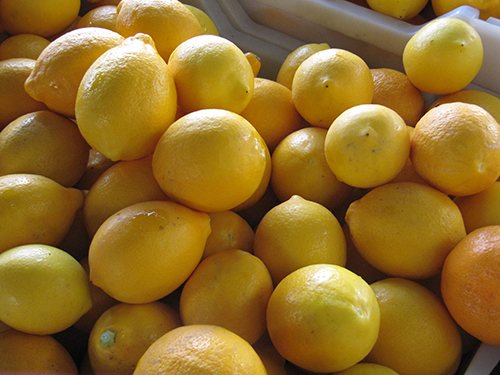

In addition, the fruits have excellent taste, and the tree itself is distinguished by increased decorativeness.
Features of the crown. At home, it grows to a height of 1.5 m, most often even lower. The shape of the crown is round, symmetrical. The Chinese dwarf tends to grow many side branches even without much human intervention. The thorns are small, there are very few of them on the branches.
A relative disadvantage is that citrus tends to grow not as a standard tree, but in the form of a bush. To create a stem, you have to do a special molding pruning in the very first years of the plant's life.
Meyer's foliage is thick, beautiful. The leaves themselves are small, deep dark green in color, very tough (denser than ordinary lemons), shiny. They are egg-shaped, with small jagged edges.
Interesting! The leaves of this plant, when rubbed in the palm of your hand, are devoid of the characteristic lemon scent. Their smell is also strong, but rather resembles an essential oil with a citrus tinge.
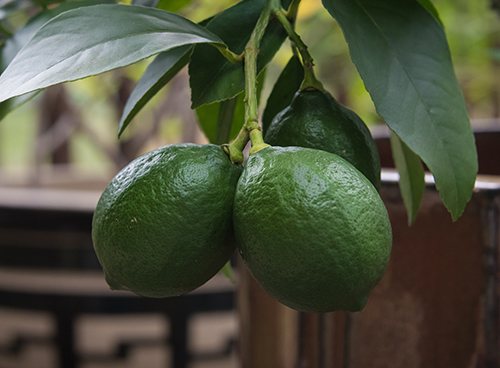

When kept indoors, this citrus tends to lose a lot of leaves in winter, sometimes they fall off almost completely. Inexperienced citrus lovers are intimidated by this fact, but you shouldn't worry too much. Usually in the spring, after an increase in daylight hours and an increase in air humidity, foliage grows back.
If you provide a cool wintering or additional lighting in winter, such a leaf fall does not occur. Apparently, this explains the scatter in the assessment of plant resistance. Someone considers it unpretentious, well tolerating dry air and lack of light, while others, on the contrary, complain that the variety is picky about keeping conditions.
Attention! By now, there are many forms and clones of Meyer. Indeed, they sometimes behave differently in grooming. This should be taken into account when introducing the "Chinese" into your collection.
And one more factor cannot be ignored when describing the crown of this citrus. It belongs to the most winter-hardy members of the family, adult specimens are able to survive a short drop in temperature to minus 10 ° C!


Characteristic flowering properties. A remontant variety, there are up to four flowering waves per season! As already noted, even seedlings bloom unusually early, and on cuttings, fruits can set in two seasons. True, at this age they are undesirable on the branches.
An important feature is that the buds appear on young shoots of the current year. They, like the blossoming flowers, have a pure white color, although some lines still differ in a barely noticeable, purple or bluish tinge. The flowers are small, about 3-4 cm in diameter, very fragrant.
Interesting! The pleasant smell of these flowers has an exciting effect on many people.
The buds are located in the crown in different ways. Singles predominate, but they often form small inflorescences.
Description of the fruits. Meyer's fruit is easy to distinguish from all other members of the species. They are small, with an average weight of 80 to 120 grams, almost round in shape. Their color is unusual - bright yellow, rather even orange. It looks much more like the color of an orange. Remember the first version of the origin of the variety? The color of the fruit demonstrates it perfectly!
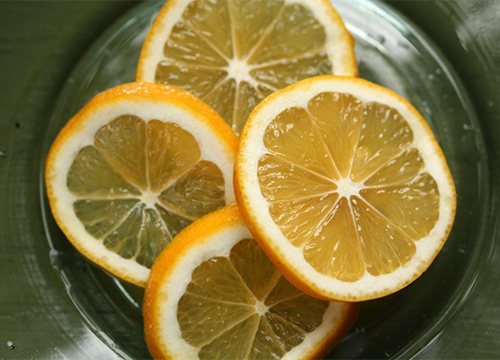

The skin is thin, easily separated from the pulp. The surface is smooth, shiny, devoid of characteristic tuberosity.
The plant is characterized by increased early maturity, sometimes only 8 months pass from bud to ripe fruit. Its disadvantage is its low transportability. To somehow compensate for this, the fruits are picked slightly unripe, later they are able to ripen.
Important! Often, consumers note the excessive acidity of the fruit. Probably, the opinion was formed precisely from the tasting of insufficiently matured specimens. A truly ripe Meyer is very sweet; it is arguably the sweetest of all lemons and can be safely eaten without sugar.
Other salient features:
- The pulp is unusually juicy, the weight of the juice is sometimes more than 51% of the weight of the fruit itself.
- The color of the pulp is yellowish, like an orange. The pulp is tender, fragrant, consisting of 6 - 10 slices.
- Most consumers note the unusual taste of the fruit. It is difficult to express in words, most often they say - "something is not lemon". In any case, along with a pleasant, delicate sweetness, there is a slight, refined note of bitterness.
- There are always a lot of seeds inside the pulp. Usually there are about a dozen of them, but there are more.
- Increased yield. Good specimens are at times simply dotted with small orange fruits.
Propagation of Meyer's lemon
There are two ways to grow a Meyer lemon: from a seed or from a cutting. A seedling obtained by the first method begins bearing fruit one year later than a tree grown by cuttings.
Another disadvantage of growing from seeds is the possibility of getting wild. When cuttings, a lemon grows, completely inheriting the varietal characteristics.
The seed growing method is as follows:
- pits are removed from the Meyer lemon. It is necessary to remove the seeds carefully so as not to damage them;
- the bones are washed and dried at room temperature;
- a gauze cloth is placed on a plate, folded several times, seeds are laid out on it, covered with a second piece of gauze, moistened with water and removed to a cool place;
- check the moisture content of the fabric, periodically add water to avoid drying out;
- when sprouts appear, the seeds are transplanted into the ground, deepening them by 3-4 cm;
- seedlings are watered once every 48 hours;
- after the height of the seedling reaches 15 cm, it must be transplanted into another container with a larger volume;
- when the thickness of the trunk reaches 8 mm, the lemon is grafted.
Read also: How to feed lemon at home
Cutting is carried out as follows:
- a stalk is cut from an adult tree, on which there are 5 leaves;
- the cutting is placed in a container filled with a weak solution of manganese for 1 day;
- 3 upper leaves are left on the handle, the rest are cut off;
- prepare a container for planting: a drainage is placed on the bottom, then a special soil mixture for citrus, purchased in a store, is poured, on top of a two-centimeter layer of sand, into which the cutting is planted;
- a glass jar of the required volume (1–1.5 l) is placed on top of the handle;
- a pot with a shank is placed in a room with diffused light; the container should not be placed on the windowsill, since bright sunlight can burn the plant;
- regularly monitor soil moisture, water as needed, avoiding drying out;
- after 10-14 days, the jar, under which the stalk is located, is first removed for a short period, then the time is gradually increased. This allows the seedling to acclimate to indoor conditions.
Propagation of Meyer's lemon by cuttings is the most successful way:
- the tree completely inherits the maternal characteristics;
- fruiting occurs 1 year earlier, i.e. at the age of 3 years.
Why do lemon leaves turn yellow
With an even yellowing of one bottom sheet, you should not worry... This means that the plant has decided to replace it. It will disappear, and a new one will appear in its place. If the color of the leaf is not bright yellow, but pale or the rest of the leaves turn yellow, you need to urgently take action. And there can be many reasons for the yellowing of foliage.
Lack of nutrients
Lemon is a plant that alternates between periods of rest and fruiting. But at home, few flower growers create a favorable environment for this. Therefore, the tree quickly depletes all micro and macro elements, even from the right soil.... And since the pantry of the nutrient reserves of the lemon is in the leaves, if there is a lack of nutrition, the plant devastates it. This is the main reason for yellow foliage.
To prevent this from happening, you should use complex citrus fertilizers once a month and according to the instructions. In winter, these are potash-phosphorus fertilizers, and in summer, nitrogen-containing ones. Top dressing is best done in the form of aqueous solutions during watering.
If the foliage has already turned yellow, water the plant with a slightly pink solution of potassium permanganate and apply foliage with iron-containing fertilizers.
During flowering and fruiting, foliar feeding is carried out carefully, trying not to get on flowers and fruits. Place the sheet on your gloved hand and spray it on both sides with a spray bottle.
Unfortunately, you remember feeding the plant when the lower leaves begin to fade. And once I had to leave for 3 months and instruct a neighbor to water the flowers. Upon arrival, it was discovered that a regularly watered lemon tree had shed its leaves. They urgently began to look for information about his resuscitation and learned that the lemon needed a rest period. After the measures taken (transplanting into a new soil, watering with fertilizers, spraying the crown twice a day), our lemon tree was covered with foliage, gratefully bloomed and gave a bountiful harvest, the first in all its 15 years of life.
Temperature and humidity conditions
Even a slight cold snap means a change of seasons for a plant, especially if a clod of earth is cooled. Therefore, in a cold draft, lemon stops the movement of juices from the root and switches to leaf nutrition, which leads to their yellowing.... To prevent home "autumn", observe the following rules:
- The temperature of the earth clod should not drop. If you need to ventilate the room, and the temperature outside the window is below room temperature, insulate the pot with a lemon tree or bush if it is impossible to transfer it to another room for a short time.
- Do not change the position of the pot from high to low, such as from a windowsill to the floor. In this case, there will also be a temperature drop in the downward direction.
- For any rearrangement, for example, from room to room, also check the temperature. It should not be downward.
If the foliage turns yellow due to the above reasons, water the plant in the next watering with water 2 degrees above room temperature and do foliar feeding.
In the south, where lemons grow naturally, the air humidity is higher than in an apartment with central heating, so remember to spray the lemon regularly. Otherwise, the lemon will begin to shed its leaves.
Light mode
A change in the light regime, as well as in the temperature regime, in the direction of decreasing, also stops the movement of juices from the root. And if the tree blooms and bears fruit at this time, then yellowing of the leaves is ensured. Adding daylight hours with cold light bulbs (to protect the plant from burns) will solve this problem. For lemon lighting, it is better to take LED or tungsten lamps.
Damage to the root system
Another reason for the outflow of nutrients from the leaves is an inoperative root system. If you do not take action in time, the plant will die.
Drying of roots
This is due to insufficient watering or strong drainage. The soil in the pot should be constantly moistened, but without waterlogging. As soon as the earth is 2 cm dry, it is moistened. With the right soil and the size of the pot, in summer, the plant is watered 2 times a week, in winter - 1 time in 7-10 days.
If there is a lot of sand or sod land in the soil, then the water passes quickly, without having time to dissolve nutrients in itself. Such soil should be replaced.
Root damage
Roots are damaged by diseases or pests (root aphids). Procedure in this case:
- Remove the plant from the pot.
- Rinse the root system in a fungicide solution (the dosage is recommended on the package), then in clean water (so that fungicides do not harm the beneficial flora of the new soil).
- Transplant into new soil.
Loss of roots
This can happen during transplantation (for example, a clod of earth was not moistened in advance) or in case of accidental damage (a pot with a plant broke). To restore the balance between the aboveground and underground parts, you will have to do unplanned pruning. What percentage of the root system has been lost, this part of the crown is cut off.
Root rot
Root rot is caused by waterlogging in the soil as a result of constant overflow or poor drainage.
The problem can be solved as follows:
- The plant should be removed from the pot, shaken off the clod of earth (along with the earth, small rotten roots will disappear).
- It is necessary to carefully cut off the damaged large roots with a sharp knife to living tissue.
- Then you need to rinse the lemon in a weak solution of potassium permanganate.
- The plant should be transplanted into new soil.
- At the end, it must be watered with water at room temperature with the addition of nitrogen-containing fertilizers.
After all manipulations with the plant, be sure to spray it with water from a spray bottle to relieve stress. And for lemon, this procedure is mandatory due to its tropical origin.
Landing rules
A Meyer lemon sapling grown from a cuttings or purchased from a store needs replanting. The best time for this is the last month of winter. In some cases, a transplant may be required at a different time:
- numerous roots are visible from the pot;
- the lemon looks drying out, and a putrid smell is heard from the container;
- the tree does not grow, does not bloom and does not bear fruit.
To help the plant, planting can be done without waiting for the end of winter. If, upon examining the contents of the pot, it is revealed that the earthen lump is completely entangled with roots, transplant into a container of larger volume. If the roots are not visible, the seedling is transshipped into a pot with the same volume.
The frequency of transplants depends on the age of the seedling. The first transplant is made to a lemon that has reached the age of two. Three-year-old seedlings are replanted twice a year. A four-year-old tree is transplanted once a year, then the number of transplants is reduced to 1 time in 2 years. Trees that have crossed the ten-year mark are replanted 1 time in 7-9 years.
Soil preparation consists in mixing several components:
- 2 parts of sod land;
- 1 part sand;
- 1 part of humus;
- 1 piece of land from deciduous forest.
You can purchase a special citrus rooting mixture at the store. It contains peat, limestone, sand, mineral and organic additives, and a growth stimulant.
- A 3 cm layer of drainage is poured into a container of a suitable volume (the height of the seedling and its root system are estimated).
- Pour a nutritious soil mixture on top.
- The seedling is placed in the center of the pot and all the cracks between the roots and walls are covered.
- The earth is well compacted with hands or a spatula.
- It is necessary to ensure that the root collar is level with the ground; it is not recommended to deepen and raise it too much.
- The seedling is watered.
Pests and the fight against them
A houseplant can be attacked by a wide variety of pests.
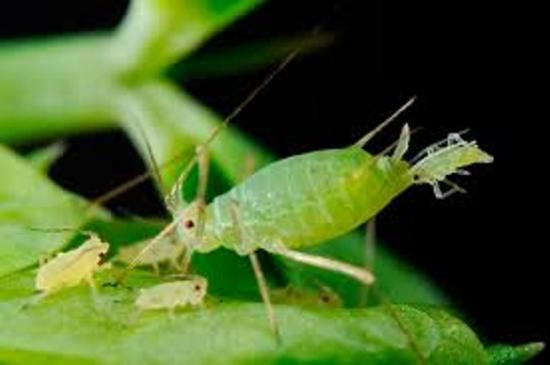

Most often it is affected:
- aphids
- whitefly
- thrips
- spider mites
- false shield
- mealybugs
- nematodes
Each of the pests weakens the tree, feeds on its juices and may well cause wilting or yellowing of the leaves, especially young shoots and leaves of plants suffer from sucking insects.
You can fight pests using the appropriate chemicals, fortunately, their choice is now simply huge. The limitation should be the fact that the processing will be carried out in a room.
If you wish, you can use homemade plant-based products that are less toxic to humans and pets.
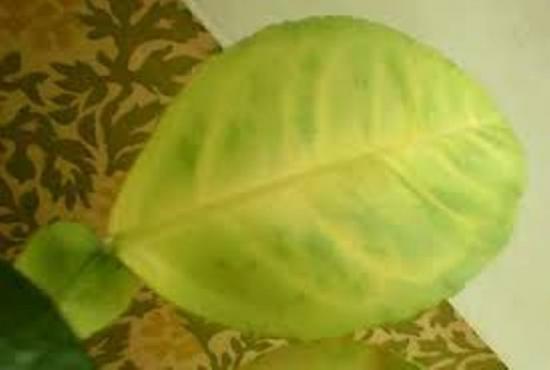

Experts say that this kind of problem can be avoided if you follow simple preventive measures:
- the soil should be disinfected before planting plants
- it is recommended to keep newly acquired flowers in quarantine for about a month, placing them next to flowers that have long been living in the house with disease-free flowers can only be made sure that they are healthy
- it is advisable to place bouquets of flowers brought into the house away from pots with other green pets
- will save citrus trees and systematic washing of leaves with running water, they can be done once a month
Meyer's lemon care
Proper care is the key to good yield for any tree. In order for a seedling to delight with flowers and a green crown, it is necessary to take a responsible approach to the issue of creating a cozy microclimate. In addition, correct trimming will help create a decorative crown. Watering and fertilizing affects the overall health of the Meyer seedling and the level of fruiting.
Crown formation and sanitary pruning
Meyer's lemon, used as an ornamental plant, needs crown formation. Pruning is carried out as follows:
- the seedling is shortened to 20 cm, while several buds should remain on top;
- shoots emerging from the buds are used as skeletal shoots. The four most beautiful ones are left, located symmetrically on the trunk, and the rest are removed;
- the length of the skeletal branches should be 25 cm, the extra centimeters are cut off;
- the resulting branches of the second order are shortened to 10 cm;
- the third row of shoots is cut to 5 cm.
After that, sanitary pruning is periodically carried out, aimed at removing broken and diseased branches, yellowed leaves.
Frequency of watering and feeding
Water Meyer's lemon in two ways: root and foliar. In the hot period, not only the soil is watered, but also the crown is sprayed daily, and in autumn and winter the number of waterings is reduced to 1-2 times a week. Too dry air in the room can lead to yellowing of the foliage, therefore, in addition to spraying the crown, air humidification is used. For this, containers with water are installed on heating radiators.
Care must be taken that the soil in the pot does not dry out, otherwise the lemon tree may die.
Top dressing is necessary for a seedling from March to November, that is, during the period of active flowering and ripening of fruits. In winter, fertilization is stopped.
Complex mineral compositions (nitrogen, potassium-phosphate) are used for feeding. They are brought in twice a month.
Once a quarter, the soil is additionally watered with compounds containing boron, iron, zinc, manganese, and copper.
Environmental requirements
Meyer's lemon needs good lighting. The duration of daylight hours should be at least 12 hours, therefore, if there is a lack of daylight, additional lamps are turned on. Lack of illumination adversely affects the state of the foliage; in the shade, the lemon sheds its leaves and may die.
Meyer's lemon tree does not like drafts and sudden changes in temperature. It is not recommended to take the tree outside in winter; it should not be kept in an unheated room either.
The comfortable temperature for Meyer's lemon in summer is +20 ° C, in winter - in the range from +12 to +15 ° C. If the plant is outdoors in summer, it is necessary to provide shading from the scorching rays of the sun.
Why do lemon leaves turn yellow, fall and curl
Often, gardeners are faced with the fact that lemon leaves turn yellow. There may be several reasons why the lemon turns yellow. Potential causes could be a lack of light or nutrients, since nutrition is very important for citrus crops. For the full development, growth and setting of fruits, elements such as nitrogen, phosphorus, iron, potassium, magnesium, sulfur, calcium are needed. Nitrogen influences healthy leaf color. Calcium is responsible for the development of the root system. Phosphorus is involved in the construction of plant cells, improves the quality of fruits, increases the content of sugar, vitamins and trace elements in them.Potassium promotes better absorption of nitrogen, accelerates the ripening of lignified shoots and ripening of fruits, increases the resistance of lemon to diseases. Timely application of fertilizers containing the above elements will help prevent yellowing, wilting and leaf fall. At the same time, the palatability of the fruit will increase significantly.
Lighting plays an important role in the formation of a healthy tree. Citrus, like any other plant in the tropics, requires 12-hour daylight hours, so the lemon is placed on the south, southwest and southeast windows. If necessary, use additional illumination.
Another reason why lemon leaves turn yellow is an excess of light. When direct sunlight hits the plant, or its prolonged exposure to the sun leads to the formation of yellow spots on the leaf plates - miniature burns, which the tree can cope with on its own if placed in a shaded or semi-shaded place. If this is not done, the lemon will completely shed the foliage and die.
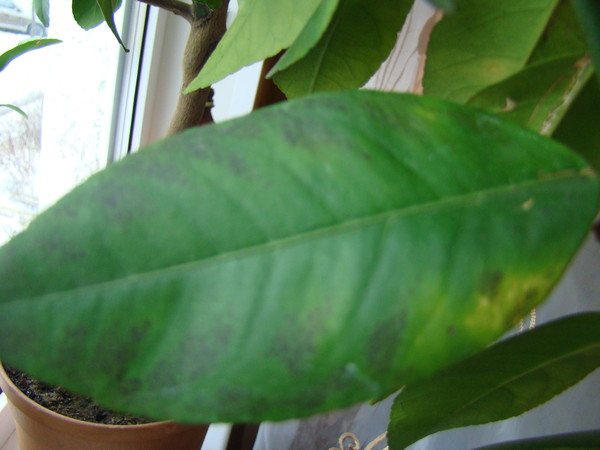

This culture is hygrophilous. Needs regular, abundant watering and high humidity (70-90%). In extreme heat or in excessively dry indoor air, the edges of citrus leaves begin to turn yellow. To prevent this, you need to spray the tree daily with a spray bottle and use a humidifier. You can put a container filled with water next to the lemon.
Dry air is often the reason why lemon leaves curl.
In some cases, the leaves turn yellow at the base and then fall off. This can be facilitated by moisture accumulating in the soil and negatively affecting the root system. With prolonged stagnation of moisture, the roots begin to rot, and the earth acquires an unpleasant odor. In this case, it is necessary to transplant the plant into another container filled with fresh soil. Pebbles or expanded clay are pre-laid at the bottom, which will provide good drainage. Before transplanting, the roots that have undergone decay are removed. Then the root system is treated with a weak solution of potassium permanganate to destroy putrefactive bacteria. After that, the lemon is planted in fresh soil.
Sometimes lemon leaves turn yellow at the edges and curl with sudden changes in temperature in the room. In the same way, citrus reacts to drafts, so the lemon pot should not be placed near the window or door.
The included heating devices can also lead to yellowing of lemon leaves.
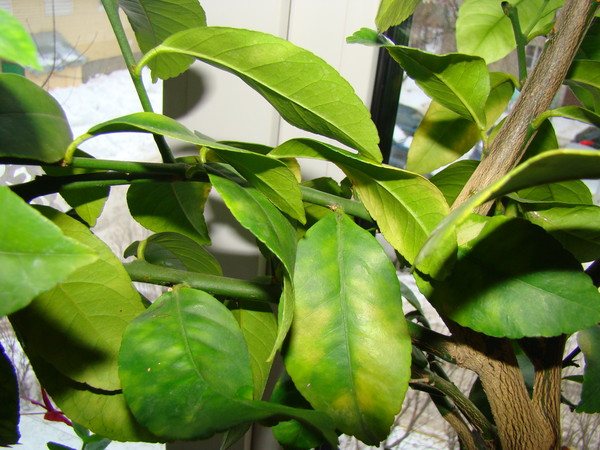

Lemon trees love moisture very much. Moreover, this applies not only to abundant and regular watering, but also to humidify the air. If the room is too hot and dry, then the tips of the leaves very soon begin to turn yellow in the lemon.... You can solve this problem by frequently spraying the plant with a spray bottle, as well as humidifying the air. To achieve the desired result, just place a container filled with water next to the flower. In addition, in such cases, the pallet is often filled with pebbles or river sand, which are periodically moistened.
If the lemon leaves begin to turn yellow not at the tips, but at the base, and then fall off, then this indicates a poor drainage system.... The moisture accumulating in the soil has a very negative effect on the root system of the lemon, which begins to rot. In this case, measures to save the plant should be taken urgently, and they must be cardinal. The lemon must be transplanted into a new flowerpot as soon as possible, which should be filled with pebbles or expanded clay by at least a third. Before transplanting, the roots of the flower should be carefully examined and with scissors removed those parts that have undergone the decay process. Then the root system of the lemon must be treated with a weak solution of potassium permanganate in order to completely destroy the putrefactive bacteria. Only then can the flower be planted in a new soil.
If you are faced with the fact that lemon leaves turn yellow at the edges and curl, this indicates sharp temperature changes in the roomwhich this tropical plant is difficult to tolerate. Drafts can also cause such problems, so a pot with lemon should in no case be placed near a window or a door. The place for the lemon should be selected in such a way that it is light and, at the same time, slightly shaded, as well as reliably protected from air currents. In addition, there should be no heating devices nearby, the operation of which also leads to the appearance of yellowness on the leaves of the flower.
Lemon Meyer's pests and diseases
Improper care of Meyer's seedling leads to the fact that the tree is sick:
- lightening, yellowing of the leaves indicates a lack of nutrients or sunlight;
- shedding of foliage is associated with insufficient moisture in the soil, therefore, urgently water the ground and spray the crown.
A spider mite can harm a Meyer's indoor seedling, so if a spider web is found, the lemon is sent to the shower.
The appearance of dots on the leaves can be associated with scale insects; a mixture of kerosene and liquid soap (1: 2) is used to combat them.
To protect against pests, an aqueous solution of karbofos and keltan is used. 0.5 l will require 1 g of each substance.
Why does lemon dry up and branches dry
Often, gardeners ask themselves the question "why does the lemon dry up?" This situation occurs when there is a lack of moisture, excessively dry air, stagnant water in the soil or with poor lighting. The possible cause should be eliminated and after a while the tree will recover.
Why do lemon branches dry? This can be due to a lack or excess of moisture. Often, dried branches indicate an invasion of a spider mite.
It so happens that the branches dry up in winter. In most cases, this indicates that the plant is acclimatizing. In this case, in early spring, dried shoots are removed, new ones will appear instead.
Another reason why lemon dries up is micronutrient deficiencies. It is recommended to alternate fertilizing with nitrogen-phosphorus-potassium or use a balanced fertilizer containing micro and macro elements necessary for the plant. Citrus reacts well to root dressing. As a result of its use, the tree pleases with a healthy appearance and a rich harvest.
Pros and cons of the variety
Like any indoor tropical plant, this lemon has both advantages and disadvantages of cultivation.
The positive aspects include:
- interesting appearance of a homemade citrus tree;
- tolerates coolness and can be grown in different climatic zones;
- subject to the appropriate conditions for keeping the citrus of a dwarf variety, it blooms profusely (often many times throughout the year) and bears fruit well;
- performs not only a decorative function, but also gives delicious juicy fruits.
Negative characteristics include:
- a high tendency to various diseases and attacks of insect pests if the rules are not followed in the care and maintenance of a standard or bush plant;
- citrus, the fruits of which are unsuitable for transportation and long-term storage.
- interesting appearance of a homemade citrus tree;
- tolerates coolness and can be grown in different climatic zones;
- subject to the appropriate conditions for keeping the citrus of a dwarf variety, it blooms profusely (often many times throughout the year) and bears fruit well;
- performs not only a decorative function, but also gives delicious juicy fruits.
- a high tendency to various diseases and attacks of insect pests if the rules are not followed in the care and maintenance of a standard or bush plant;
- citrus, the fruits of which are unsuitable for transportation and long-term storage.
In this video, you will hear helpful tips for growing lemon.
Treatment of fungal diseases
1.1. Anthracnose
This disease, caused by pathogenic fungi, is most often found in greenhouses and greenhouses, but if the apartment is humid and too warm, and there is not enough phosphorus and potassium in the soil, it can also appear on indoor lemon. Initially, anthracnose manifests itself by the appearance of dark brown spots on the tips of the leaves. If the disease is started, the plant loses its foliage, ovary, fruits, it has necrosis of shoots, gum flow, which often leads to the death of the entire aerial part of the tree.
In the early stages of the disease, lemon can be saved. It is necessary to remove the affected parts of the plant, and then spray with fungicides. Such drugs as Fitosporin (20 drops per 0.5 l of water) and copper oxychloride (4 g per 1 l of water) have proven themselves quite well. Bordeaux liquid is more powerful in its effect (3-4 grams per 1 liter of water). The interval between spraying is at least 7 days. The treatment is carried out several times, depending on the degree of damage to the disease, according to the instructions. Sometimes 3 times are enough.
1.2. Powdery mildew
The disease is characterized by the following symptoms: the appearance on the leaves of a white, flour-like plaque, a slowdown in the growth of a tree, yellowing and twisting of the foliage. Powdery mildew is fought by repeatedly spraying plants with 3-4% Bordeaux liquid, a solution of copper sulfate (5 grams per 1 liter of water) or other fungicides. For prophylaxis, it is recommended to treat lemon with Fitosporin (in accordance with the instructions). It should be noted that indoor lemons rarely get sick with powdery mildew.
1.3. Scab and wart
With scab disease, any part of the plant can become covered with raised spots. Over time, instead of them, holes appear on the leaf blades, and the branches and fruits crack at the lesions. Wart also appears as patches that later develop into pink-gray warts. They gradually increase in size, turning into growths that can appear on leaves, shoots, fruits, leading to their death. The disease causes the ovaries to fall off.
The fight against scab and wartiness begins with the removal of the affected parts of the plant, and then the tree is repeatedly sprayed with fungicides: solutions of Bordeaux liquid, copper or iron vitriol, copper oxychloride (according to the instructions). Drugs such as Cuprozan or Strobilin are also suitable.
1.4. Sooty fungus (rabble)
The appearance of a sooty fungus, a type of mold, is provoked by harmful insects: aphids, scale insects, scale insects, etc., emitting a sticky sweet substance. Therefore, first of all, it is necessary to fight with them. The mob spoils the appearance of the lemon, weakens it, since the dark plaque covering the stems, trunk and leaves interferes with photosynthesis, as a result of which the plant slows down its development. Soot fungus is removed with napkins, tampons, a soft toothbrush, using warm running water. Insects are removed along with the plaque. After this procedure, the plant should be treated with insecticide preparations that are suitable for the destruction of a particular pest.
1.5. Late blight
This disease is most often affected by lemons grafted onto an orange. Plants can become infected through the air from carriers of fungal spores such as eggplants, tomatoes, peppers while cutting vegetables. Late blight shortens the life span of a tree, provokes the death of its individual parts, appearing on the root collar, trunk, branches, roots, buds, ovaries, fruits and leaves.
The disease is quite difficult to treat, especially if it spreads to the bark. Dark watery spots appear on it, which then swell and crack. Gum begins to stand out from the wounds; when it gets into the ground, it smells unpleasant.Late blight can also lead to decay of the root system. On the shoots, the disease manifests itself in the form of spots, at first small and light, and then acquiring a light brown color and growing along the branches (from the tops to the trunk). Cracks appear on the surface of the spots with gum oozing from them. Affected shoots gradually die off.
On leaf blades, late blight manifests itself as oily spots (closer to the top of the leaves). Over time, they turn brown and increase in size, covering the entire surface of the leaf; a white-gray coating may appear on the underside. If the disease affects buds or ovaries, rot will form on them. Affected fruits turn brown, acquire an unpleasant odor and gradually dry out.
The appearance of the disease is facilitated by high air humidity (more than 90%) at a temperature of + 18-20 degrees. Lemon is saved by removing diseased parts of the plant and spraying it with fungicides containing copper (for example, a solution of copper sulfate - 1 tsp for 2 liters of water), or with drugs such as Albit, Profit, Ordan and others. When pruning shoots or roots, grasp 10-12 cm of healthy wood. Places of cuts are treated with a 10% solution of copper sulfate.
Description
Plant height in open ground it can reach 5 meters. However, in indoor conditions, it rarely reaches a height of more than 2 meters. On average, its height is 1 meter.
Leaves small, evergreen, dark green. It blooms very beautifully: the inflorescence is in the shape of a bunch. Flowers are small in size, purple or white. Flowers smell very nice.
Fruit are rounded and small in size. The average weight of the fruit is 100 grams. The rind is orange or bright yellow.
In the photographs you can observe all the beauty of this species.
Next, we'll talk about home care, diseases, pests, and more.
Botanical description
What is this plant? Lemon Meyer (Latin name Cítrus × méyerii) is a perennial plant of the Rutaceae family, which is a hybrid of an orange and a lemon. It was first brought to the United States from China by the scientific researcher Frank Meyer in 1908. The second name for the plant is Chinese dwarf lemon.
At home, it grows in natural conditions and reaches a height of 6-8 meters. Gradually, the variety spread from the United States all over the world, and they began to grow it as a houseplant. And its fruits began to be used in cooking.
general characteristics
Meyer's lemon is a small tree 1.5-2 meters high. It has dark green leaves that are shiny and oval. Plants of this variety differ from their counterparts in high productivity and the ability to grow in a variety of climatic conditions. This variety has a moderate growth rate and early flowering. Taking care of this lemon is easy, even a beginner citrus grower can handle it.


A whole bunch of fruits can ripen on an already mature Meira lemon
Resuscitation of rotten roots
Root decay is often a consequence of yellowing and leaf fall caused by poor watering.
Waterlogging of a lemon tree will inevitably lead to its death, so it is important to reanimate the lemon in a timely manner.
It is important to examine the roots of the lemon tree and remove any damaged parts. The culture is reanimated like this:
- Gently remove the lemon tree from the pot and shake the roots off the ground.
- Examine the root system for rot. All affected parts are removed with scissors or a blade, the sections are treated with charcoal.
- The roots are dried for 15-20 minutes, the tree is planted in a new container.
After transplantation, the culture is watered. With the correct organization of the lemon content, the tree will recover in 2-3 weeks.
Features of the growth of Chinese lemon
Meyer's lemon is grown in a room with little effort. This is the most unpretentious variety.It combines the positive qualities of lemon and orange.
The main features of the growth of Chinese lemon:
- Frost resistance. The plant is able to withstand low temperatures, but does not like drafts and sudden changes in climate.
- Flower buds form on both adult and young shoots.
- The first fruiting is observed already in the second or third year of the tree's life.
Mayer's lemon blooms and bears fruit all year round. During the flowering and fruiting period, the plant should not be exposed to stress - transplanted, pruned, taken out into the street.
Diseases of lemons in indoor conditions
Indoor lemon has a fairly large list of possible diseases. Let's consider the most common ones.
Chlorosis
This disease occurs as a result of stagnation of moisture, acidity of the soil, deficiency of iron and other elements. In this case, there is a decrease in the activity of photosynthesis and the formation of chlorophyll. The first sign is yellowing of the leaves, and then they fall off. Then the tops of the shoots can dry out, the roots die off, the leaves are crushed.
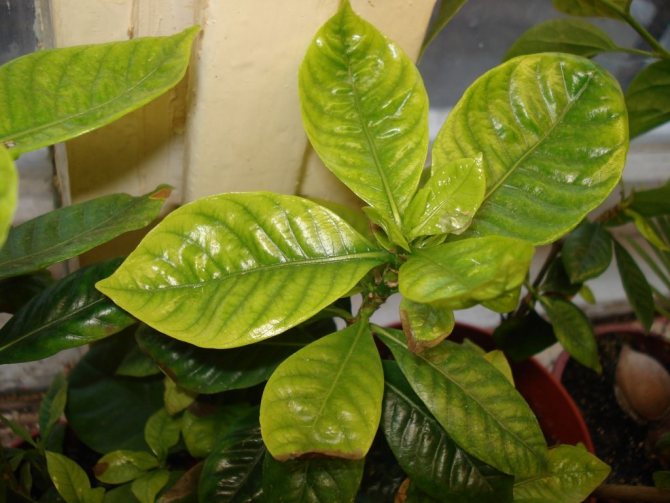

With chlorosis, the soft tissues of the leaves turn yellow, and the veins remain green.
It is clear that the disease is caused by a violation of care, therefore, first of all, they need to be eliminated:
- Get rid of stagnant moisture, dry the soil, replace it if necessary. Rinse and dry the drain. You may need to transplant to a different, smaller pot.
- Check the acidity of the soil with litmus paper. If it is high, then the soil should be deoxidized by adding fluff lime or chalk. To do this, take half a tablespoon of the powder and dilute it in a glass of warm water, and then water the soil in a pot. Measure the acidity of the water flowing out of the drainage holes, and if it is still high, then the procedure is repeated until the pH level is in the range of 6-6.5 units.
- Replenish iron deficiency by introducing preparations containing it in a chelated form, such as Ferrofit, Ferrylene, Antichlorosis, Micro-Fe and the like. Or you can simply dissolve 20-40 grams of ferrous sulfate in one liter of water and feed the plant.
Phylostictosis
This fungal disease is also called brown spot. A symptom of the disease is the formation of brown or dark brown spots on the leaves of a round, oval or irregular shape. If you do not start treatment, then the spots, growing, cover the entire surface of the leaf plate, after which the leaves dry up and fall off. Favorable conditions for the development of the fungus are dampness and air temperature +25 ° C and above. The source of infection is soil, water, purchased flowers, etc.
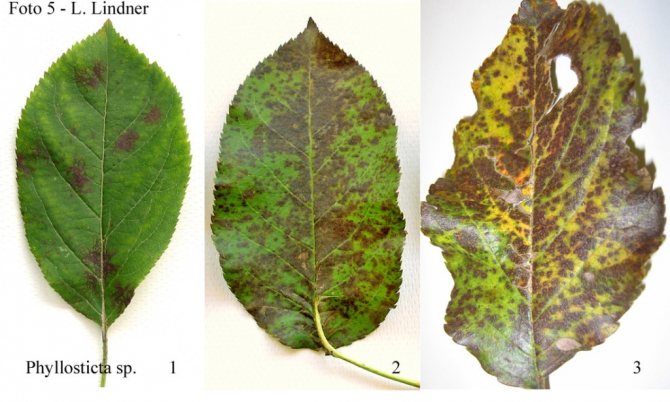

When phyllostictosis is affected, brown spots are formed on plant leaves
To cure the plant, you should cut off the affected leaves and treat the crown with fungicides (these are drugs to fight fungal diseases). Popular drugs are Horus, Quadris, Abika-Peak and others. It is better to use them outdoors, but if you still have to use them indoors, then take precautions - prevent drugs from getting on food or dishes, after processing, ventilate the room. If the infection is not strong, then it is better to use biological products such as Fitosporin-M, which is absolutely safe for humans, animals and bees. At the same time, it is also a fertilizer, as it contains humic acids.
Anthracnose
It is also a fungal disease that often infects lemons in greenhouses and greenhouses. If the room has high humidity and temperature, then indoor lemon can also be affected by the disease. Anthracnose can be recognized by the formation of dark brown spots on the leaves, capturing the edges. With a strong defeat, the fungus spreads to the shoots and fruits, all the leaves dry out, the aerial part of the plant dies.


Anthracnose can be recognized by the formation of dark brown spots on the leaves, covering the edges.
Prevention and treatment are the same as for other fungal diseases.
Citrus Cancer
If the leaves of the lemon have dark brown spots with a yellow border, similar to small tumors, this means that the plant is infected with the citrus cancer virus. He is not able to harm a healthy plant, but if it is weakened from other diseases or poor-quality care, then cancer will begin to develop. At the same time, he, starting on the leaves, will subsequently move on to fruits and shoots. They have not yet learned to fight the disease, so the plant will certainly die. Without expecting this, it is destroyed as quickly as possible so as not to infect healthy lemons and other citrus fruits, if any. Prevention - careful observance of the rules for caring for lemon, as well as regular processing of the crown with a weak solution of potassium permanganate with an interval of 3 months.


If the lemon leaves dark brown spots with a yellow border, the plant is infected with citrus cancer virus
Video: lemon disease
Treatment of infectious diseases
The main infectious diseases of lemon are gommosis and root rot.
2.1. Infectious gommosis (gum flow)
Hommosis, as already mentioned, can appear for various reasons, including due to infection of the tree through mechanically obtained wounds. When the pathogen enters the plant, brown-red longitudinal spots appear on its trunk and branches, which crack. A sticky substance is released from the cracks - a gum, which, when solidified, resembles a resin. In places of gum flow, the bark dies off, the leaves, due to the blockage of the vessels, do not receive nutrition, turn yellow and fly around.
Gommosis is treated by pruning diseased branches (with a ten-centimeter grasp of healthy bark), cleaning the affected areas on the trunk, followed by disinfection with a 3% solution of copper sulfate. Wounds are treated many times until the cessation of the treatment.
2.2. Root rot
The disease manifests itself as a massive drop of foliage, often with no signs of any damage. Sometimes, with a disease of root rot on the trunk of a tree, you can notice spots with a dirty substance oozing from them. The disease occurs due to waterlogging of the soil, as well as when the root system is infected through wounds obtained, for example, when a plant is transplanted or damaged by pests.
Having found rot, the affected roots are removed in whole or in part using a sharp knife or pruner. Places of cuts are treated with activated or crushed charcoal, rooting stimulants. The old soil must be replaced with a new one. It is not recommended to water the lemon after transplanting for 6-7 days in order to avoid repeated decay of the roots. Instead of watering, the leaves are wiped with a damp cloth. During this period, it is recommended to provide the tree with diffused lighting for at least 12 hours. If the daylight hours are short, the plant is provided with additional illumination using fluorescent or phytolamps.
Unpretentious and original Meyer's lemon: care and breeding
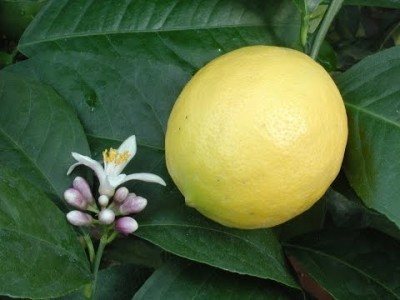

Meyer's lemon, or lemongrass chinensis, is a perennial tree belonging to the Citrus genus.
Root family. The plant is named after American scientist F.N. Meyer. It was he who brought this plant from China to North America in 1908.
The original appearance and unpretentious care made Meyer's lemongrass a very popular plant, but in the forties of the 20th century it turned out that lemongrass is easily affected by viruses, and the plant was banned for a long time so that lemons of other varieties would not be infected from it.
And only after botanists managed to develop a new version that is resistant to viruses, the plant again became very popular all over the world.
Photo
In the photographs you can observe all the beauty of this species.
Next, we'll talk about home care, diseases, pests, and more.
Causes of yellowing of lemon leaves
Often, improper care of the plant becomes the cause of yellowing of the leaves. If the lemon leaves turn yellow, it may be responding to one of the following factors.
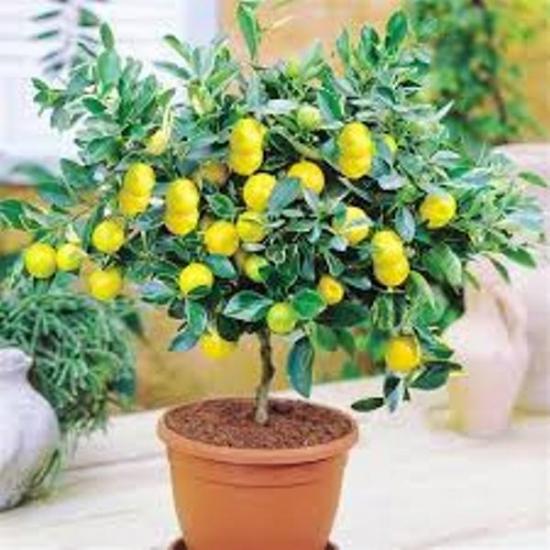

Incorrect lighting
Both excess and lack of light can cause yellowing of the leaves. When exposed to direct sunlight, yellow burns appear on the leaves. If the lemon has light leaves with yellow dots, it is too dark.
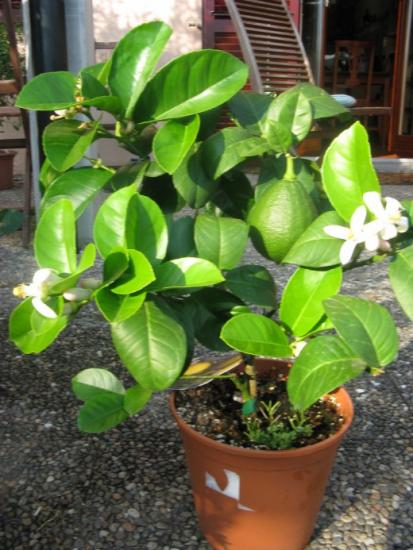

Uncomfortable temperature
Lemon is a thermophilic plant. It reacts negatively to drafts and temperature changes. If the citrus freezes, then its leaves begin to turn yellow and curl around the edges. As a result, indoor lemon sheds its leaves.
Excess watering
He loves wet soil, but everything needs a measure. Due to excess moisture, the roots begin to rot. At the same time, the leaves evenly turn yellow and fall off.
Depleted ground
If yellow dots appear between the veins, then there is not enough power.
Dry air
Citrus fruits are native to the tropics, so they prefer high humidity air. If the tips of the leaves dry on a lemon, the leaves gradually turn yellow and fall off, this suggests that the air is dry for citrus fruits.
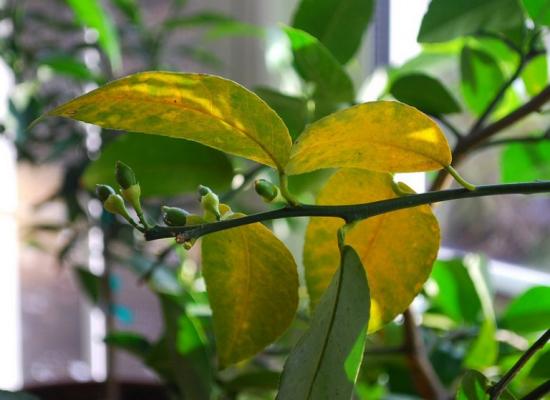

Diseases
Lemons are highly susceptible to various diseases. At home, it is difficult for them to become infected, but there is a great risk of acquiring a diseased sprout. If the care is correct, and the tree still turns yellow and dies, most likely the disease is to blame.
Natural causes
If 1-2 leaves have turned yellow, and the rest of the plant looks healthy, this is most likely a sign of natural foliage renewal.
Lemon viral disease treatment
Such diseases pose the greatest danger to lemons, since they cannot be treated. Plants with signs of a viral infection are recommended to be destroyed. But before you do this, you need to make sure that the tree is suffering precisely because of the disease, and not because of improper care, since the symptoms in both cases are very similar. This is a slow development, deformation of branches and leaves, a change in the color of leaf plates, etc.
Lemon should be placed in a separate area where there are no other indoor plants. After carrying out the necessary procedures for several weeks: transplanting, feeding, pruning, etc., you should see if they help the plant or not. In the latter case, the tree must be disposed of. Viruses often get on lemons with insects, contaminated soil, during grafting or are transferred from diseased plants in the immediate vicinity.
3.1. Xylopsorosis
This dangerous virus that infects lemon bark can remain dormant for up to 10 years without manifesting itself. Symptoms of the disease resemble gommosis - gum flow. The leaves of the infected plant curl and fall off.
3.2. Tristeza
Young (under 5 years old) and weakened trees are especially susceptible to this virus. In diseased lemons, the bark dies off, the plant practically does not develop, its fruits become smaller, the veins of the leaves become thick and light. Then the foliage turns yellow, dries up and falls off.
The tristesis virus (like xylopsorosis) does not manifest itself on some varieties of indoor lemons (for example, Meyer's lemon) even if infected. But without getting sick themselves, they are carriers of dangerous viruses. Therefore, using cuttings taken from such carriers for grafting, flower growers can infect a healthy plant.
3.3. Sheet mosaic
With a disease, a characteristic pattern appears on the leaves of the plant in the form of light stripes or strokes. Lemon grows poorly, leaves are deformed and fly around. Leaf mosaic is not as dangerous to the plant as the above diseases, but it is also incurable.
Growing varieties
Landing requirements
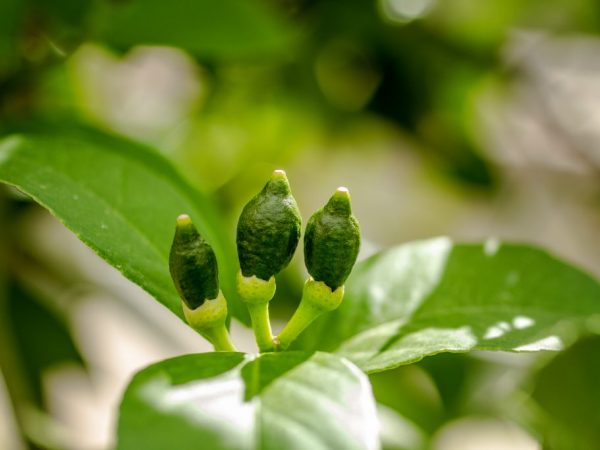

Buy a grafted seedling for growing
Meyer's lemon can be purchased or planted by yourself. If it is a purchased copy, it must be grafted, i.e. go through the stock to give a good harvest.It is easier to grow a variety from a cuttings planted during the warmer months.
The propagation of Meyer's lemon is carried out from a perennial culture. The seedling must be grafted and soaked in a special solution (not less than 10 hours). If you plant a one-year-old cutting, the citrus will not take root or will grow weak. Young plants need transplanting - such activities will help improve the growth of the bush. In most cases, lemon propagation is carried out using seeds that are extracted from the fruit or by cuttings.
Landing in the soil
Meyer's lemon is planted in pots. Young seedlings are immersed in specially prepared soil. For such a mixture you will need:
- a piece of leafy land;
- part of the sand;
- part of humus (fertilizer);
- two parts of turf land.
This soil will provide the young shoots with all the nutrients they need for vigorous growth. For a lemon tree, a soil with neutral acidity is selected. The root collar is immersed in the pot at the same level with the top layer of soil - this is an important condition for the rapid growth of the seedling. After planting, the seedling is watered abundantly. A young shoot is transplanted every year until the age of five - after that, the tree grows in a permanent pot, and only the upper layers of the soil change. During planting, drainage is established for the plant, which will not allow water to stagnate and the root system to rot.
Plant care
Caring for Meyer's lemon at home consists in constant watering, fertilizing the soil, pruning excess branches. Additionally, lighting is installed, without which the Meyer lemon does not grow. An important condition for the proper development of a lemon bush is air humidity. A humid climate is the most suitable environment for a seedling to grow.
It is impossible to put a pot near heating systems, if a window sill with good lighting is chosen for growing, then there should not be batteries or heaters under it. Additionally, the air around the bush is sprayed with plain water - this creates additional moisture. Citrus care involves constant pruning. Pruning Meyer's lemon is an important step. Not only the shape of the crown is formed, but the growth of young branches and old shoots is also regulated, which draw nutrients from the bush.
Fertilizing the soil
Grooming for Meyer's lemon includes constant soil fertilization. The main dressing is carried out through the leaves - fertilizers are added to the water to spray the foliage. So the tree receives more nutrition, which is evenly absorbed by the bush. If the plant has recently been transplanted, it does not need feeding. The seedlings are watered - this is enough for their rapid growth. After a period of adaptation, regular feeding begins. For this, mineral and organic fertilizers with low concentrations are used. Such care is carried out seasonally. From April to September, branches are pruned and the root system is fed. Top dressing is carried out 2-3 times a month. From January to April, fertilizers are applied once a week. In the winter, you have to take care of the plant periodically - there is enough watering once a month. Additionally, dry leaves are removed (feeding is not carried out).
Watering
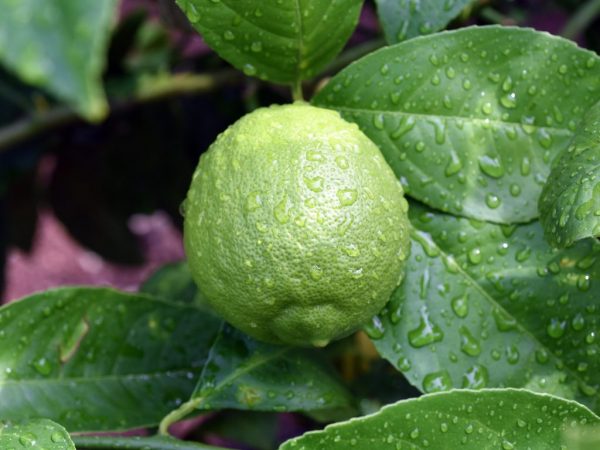

The variety needs constant watering
Meyer's citrus needs constant watering. The higher the ambient temperature, the more and more intensive the watering. In winter, Meyer's lemons are watered no more than once every 2 weeks. In autumn and spring, water is added as the soil dries.
When pruning is done, citrus is watered more often - the root system needs moisture to recover faster. Watering is carried out in moderation: you cannot fill the entire soil layer, but only moisten it a little. Excess moisture does not threaten the citrus due to the drainage layer that must be installed when planting the seedling. Watering is increased if the bush is recovering from an illness.
Lighting and temperature control
Meyer's lemon care involves intense lighting. The best place to grow culture is on the south side of the premises. On the street, the tree is also installed in a lit place. In the house, if there is little light, especially in winter, artificial lighting is installed. For abundant fruiting, the culture needs the correct temperature regime.
Cold wintering is needed to slow down the processes in the tree, so it cannot be overheated. The optimum air temperature is 12 ° C. Citruses do not tolerate sudden changes in temperature. If the plant is transferred to the yard, it is hardened before that. The same steps are needed before bringing the culture back into the house.
Transplanting a seedling
Meyer's citruses are transplanted every year until a root system is formed. Three-year-old trees are transplanted less often, and after 5 years of active growth, a permanent pot is selected for the bush. The transplant is carried out urgently if the bush began to hurt or fade. In such cases, the problem is in the composition of the soil or lack of nutrients.
Immediately after transplanting, the plant is abundantly watered and fertilized. It is better to replant the tree in the fall before the cold snap or in the spring before the first ovaries appear. Before transplanting, the soil in the pot is watered abundantly so that there are no problems with the separation of the root system. During transplantation, the earthen lump cannot be completely removed, otherwise the damage to the root system will be difficult to fix.
The composition of the soil for transplanting:
- a piece of leafy land;
- part of the sand;
- some of the fertilizer or humus;
- part of the clay;
- three parts of turf land.
The culture is transplanted into a pot, which is 2 times larger than the previous one. You can not choose too large a capacity so that the root system is not depleted.
Description of the appearance, flowering and fruits and photos of the plant
In indoor conditions, it grows 1–2 meters. The crown is round, compact, and lends itself well to shaping. The leaves are small, shiny, oval, dark green in color, with jagged edges. The inflorescence is in the form of a bunch.
Reference. The flowers are snow-white or purple, strong-smelling, are formed on both adult shoots and young branches.
Fruits are small in size, round, without a nipple, from 70 to 140 grams. The zest of a lemon is dark yellow in color, after a while it turns orange. The rind is smooth and thin. 10–12 seeds per fruit.
Below are photos of Meyer's lemon:
Cutting the lemon correctly
If you do not prune, problems may appear not only with development, but also with fruitful qualities. To enjoy delicious lemons every year, you should partially remove the flowers. The tree spends a lot of energy on them, depletion occurs, and the amount of ovary is significantly reduced.
When a young tree grows up to 20-25 centimeters, a trunk is pinned to it. Thus, lateral branches go into development. Branches that grow upwards can even need to be cut off. Until the branches are fully formed, the tree will not bear fruit well.
If the lemon pot is not periodically turned to the sun, the tree will grow one-sided. Therefore, twist it more often to form the correct shape. The frequency of reversals is once every 10 days. Sometimes they resort to using wire to direct the growth of branches in the desired direction.
Fruit cutting is an important process. Many people cut the lemon carefully, capturing only the stem. But it's not right. You also need to cut a little twigs (with several internodes). This stimulates the growth of branches.
Feedback and recommendations
According to flower growers, the Meyer lemon grows into a beautiful tree with bright yellow fruits, sometimes even orange ones. With proper care, it bears fruit from 2-3 kg per year. I like its compactness, accessibility to move from one place to another.
Taste qualities make it possible to make lemon juice from the fruit, which is mixed with orange juice. They also add slices to apple jams, pies, make a preparation with sugar for tea.
To protect the plant from pests, the Meyer tree should be sprayed with medications in spring and autumn. For 1 liter of water, stir 2 g of karbofos and keltan.
Features of feeding
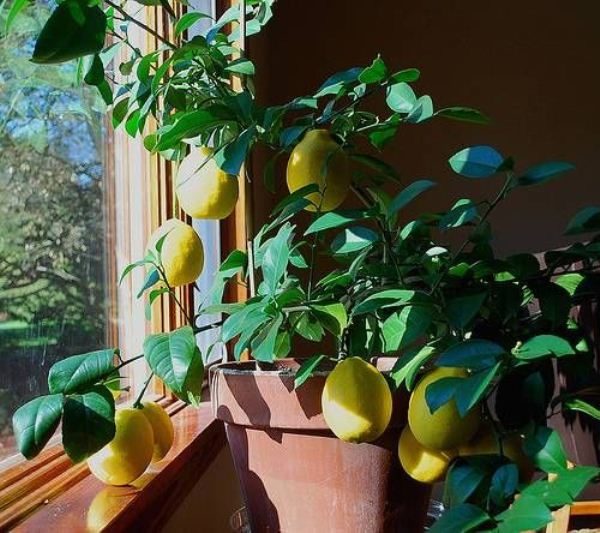

During flowering and fruiting, Mayer's lemon should be fed
The plant especially needs feeding during the growing season. For this, experienced florists recommend once every 2 weeks during the period from early spring to late autumn (while the lemon is actively blooming and bearing fruit) apply complex mineral fertilizerscontaining nitrogen, potassium or phosphorus.
At the same time, there is a little trick, following which you can improve the effectiveness of mineral fertilizers. To do this, once every 2-3 months, the soil is watered with a solution of boron, molybdenum, copper, zinc, manganese or iron.
For the winter period, feeding must be stopped.
How to properly harvest lemon fruits
Plant height in open ground can reach 5 meters. However, in indoor conditions, it rarely reaches a height of more than 2 meters. On average, its height is 1 meter.
The leaves are small, evergreen, with a dark green tint. It blooms very beautifully: the inflorescence is in the shape of a bunch. Flowers are small in size, purple or white. Flowers smell very nice.
The fruits are round and small in size. On average, the weight of the fetus is 100 grams. The rind is orange or bright yellow.
Differs in a specific taste. More like an orange than a lemon. And this should not be surprising: after all, Chinese lemon is a natural hybrid of lemon and orange.
When assembling, it is important to use scissors or a knife, which will give the process a neatness. The number of fruits will depend on many factors. Here is the age of the plant, and the correct feeding and irrigation, and the creation of the necessary climate. The same factors will determine the taste. Growing meyer lemons at home is a pleasant business because of the wonderful fruits, but it also requires a lot of attention and work.
What is this plant? Lemon Meyer (Latin name Cítrus × méyerii) is a perennial plant of the Rutaceae family, which is a hybrid of an orange and a lemon. It was first brought to the United States from China by the scientific researcher Frank Meyer in 1908. The second name for the plant is the Chinese dwarf lemon.
At home, it grows in natural conditions and reaches a height of 6-8 meters. Gradually, the variety spread from the United States all over the world, and they began to grow it as a houseplant. And its fruits began to be used in cooking.
In indoor conditions, it grows 1–2 meters. The crown is round, compact, and lends itself well to shaping. The leaves are small, shiny, oval, dark green in color, with jagged edges. The inflorescence is in the form of a bunch.
Reference. The flowers are snow-white or purple, strong-smelling, are formed on both adult shoots and young branches.
Fruits are small in size, round, without a nipple, from 70 to 140 grams. The zest of a lemon is dark yellow in color, after a while it turns orange. The rind is smooth and thin. 10–12 seeds per fruit.
What is required
Meyer's lemon is small in size and moderate in growth rate at home. At the same time, the bush is distinguished by excellent productivity, resistance to low temperatures. A tree at home can bloom several times all year round, with the greatest flowering in the spring.
When choosing a Meyer lemon for home cultivation, it should be remembered that the harvested crop does not have good keeping quality and does not withstand processing well. Therefore, if you plan to grow lemons for sale at home, then the Meyer variety, despite its ease of care, is not suitable for these purposes.
Fruiting of this citrus variety usually begins at home in the 5-7 year of the tree's life.During the season, from a large lemon tree of this variety, you can get 2-3 kilograms of great-tasting fruits. It should be borne in mind that from the moment the ovary is formed to the ripening of the fruit, it takes about 9 months even with intensive care.
Planting, caring for and growing indoor lemons of this variety is not particularly difficult. You can use cuttings from a fruiting indoor lemon, or plant seeds from fruits that are obtained from a varietal tree. Experts recommend using small cuttings for planting at home, which not only allows you to speed up the first harvest, but also solves problems with late flowering, which can be observed in trees grown from stone.
Reproduction by cuttings at home is carried out using standard technology. You need to cut a small 10 cm twig with several fully developed leaves and three to four buds. It is recommended to soak the lower part of such a cutting for several hours in a growth stimulator, and then plant it in fertile soil to a depth of about 3 centimeters.

